MATTERS




Cover: Running Hare, Mere Down by James Lynch
James has achieved recognition for his landscape paintings of the West Country in which he sometimes includes wildlife. He uses the ancient medium of egg tempera, making his own paint from raw pigments, egg yolk and water. Egg tempera paintings have a haunting luminosity. James exhibits in London and Wiltshire and accepts commissions. www.james-lynch.co.uk
Editors: Mark Lewis, Marlise Jolliffe
Proof Readers: Marilyn Wright
Artwork: Shaun Hodge
Show/Farm Sale photos: Rob Nolan
Printed by: Remous Print Ltd., Barton View Bus Park, Sheeplands Lane, Sherborne, Dorset DT9 4FW tel: 01963 250920 www.remous.com
The contents of this publication are intended as guidance and general interest. It does not constitute legal advice and can be no substitute for considered advice on specific problems. Although every effort has been made to ensure the accuracy of the information printed in this publication, Symonds & Sampson LLP cannot accept liability for errors and omissions. The views expressed in this publication are not necessarily those of Symonds & Sampson LLP.

"How is everything at Symonds & Sampson?” This is the question most frequently posed to me by our clients and friends. It is understandable; we’re currently in a time of great structural, economic and legislative change which is inevitably causing confusion in residential, agricultural and commercial sectors. We aim to provide clarity.
Our partnership has spent a significant amount of time considering the changing landscape. We anticipate a number of challenges for our clients in the short and medium term, which has led to considerable investment in our technology, and the continuing professional development of our staff. We have strengthened some of our divisions and, in particular, we have brought in an experienced and established commercial team to broaden our base.
We cherish our position as the leading firm of chartered surveyors in the region and appreciate that not only are our clients’ needs changing but also the range of people we advise is now much more diverse.
However, whoever the clients may be, they all seek trusted professional advice and a truly outstanding service. I believe that we have the right blend of people, of different ages and experience, to provide this. Our aim is to develop and nurture enduring relationships with clients and their families by always providing impartial advice and building trust for generations.
We are very aware of the pressures of modern life on our clients as well as our staff. Our chosen charity in 2020 will be four regional branches of Mind covering Dorset, Devon, Somerset and Wiltshire. The charity educates people about the symptoms of mental ill health – what they are, what to expect and how to spot them. It will also educate people about what they can do when they experience symptoms themselves or recognise them in someone they know, and challenge the stigma and equality of this often paralysing illness. We will be holding a number of fundraising events throughout the year and we hope you will feel able to support us.
You will notice the striking image by James Lynch on the cover of the magazine and, throughout Country Matters, we are highlighting the vast amount of artistic talent across our region. If you like a particular image, please do contact the artist.
I hope you enjoy the articles in this year’s magazine and, in answer to the question at the beginning, we continue to go from strength to strength with the help of our dedicated and experienced team who are ready to offer advice on anything you put to us throughout the year.

Peep behind the curtain at S&S with insights from our Managing Partner and a rural surveyor. Discover the difference between benchmarks and trig points, how schoolchildren are turning Dorchester plastic-free, and how we can help manage your residential or commercial assets. Read on for sartorial suggestions, good news for art lovers, and profit-boosting rural planning advice. Get the low down on barn conversions, floristry, and the link between bats and planning applications. There’s the buzz of beekeeping and a cautionary tale about runaway pigs. Your tax planning toolkit, tips on how to diversify for success, and our expert guide to maximising planning opportunities.
t Summer Blues, Colmer’s Hill by Marion Taylor, www.dorsetpaintings.co.uk

We have the freedom to maintain a true breadth of services, built up over many decades, whereas many of our competitors are owned by outside shareholders whose primary focus is often the next year-end dividend. It is this range of skills and activity that gives the essence of who we are.
I would hope so, but inevitably, with a fair proportion of our costs being staff overheads, we have to be constantly mindful of possible economic challenges ahead when recruiting for planned growth. We don’t have to react as dramatically as other estate agencies to changes in the market. If residential property is affected we can rely on other disciplines to maintain profitability .
Personally no; with my rurally-focused professional work I am based in a modern office in Poundbury where parking and access for clients is easier. The internet has changed the nature of estate agency and we constantly question whether we need so many offices. The answer is that everything is under review, but for now we believe that a high street presence is important for our residential sales and lettings teams.

Ironically, providing a breadth of service can require more resources because of the internet. We have to know everything about a property – its idiosyncrasies, things to do with listed buildings, easements, restrictive covenants or how a property could be affected by planning issues.
Symonds & Sampson employs more than 150 full- and parttime staff, and recruitment of younger professionals is a particular problem in rural areas. They want the job, but in a glitzier location!
We have various categories of partner which enables ambitious people to move up the ladder. Initial promotion to a salaried partner reflects ambition and gives kudos but without any financial liability.
Further promotion to non-equity partner reflects in the individual a wider appreciation of our overall business and their responsibility. They get a greater slice of the profit without any capital outlay. It means that the step up to being invited to become a full equity partner is part of a gradual process that allows talent to move up and get a feel for the business and all that it encompasses.
The increased pace of working life. My day now is more of a juggling act, with emails a constant attention-grabber. There is an expectation from clients to have answers straight away.
I would say delegate more. I have tended to think it will be quicker if I do what’s needed, but it would have made my life easier if I was better at delegating and trusting other people to get on with it.
In conversation with Richard Miller, our Managing Partner Richard Miller MRICS FAAV Managing Partner Poundbury rmiller@symondsandsampson.co.ukInterview by Alex Foster, Director & Chartered Financial Planner, Ward Goodman, as part of a report to appear in DECISION magazine
My day now is more of a juggling act, with emails a constant attention-grabber

Have you ever spotted a strange marking on the side of a church or building and wondered what it was? If it had a chiselled horizontal line with an arrow head below, it could be a benchmark.


These are used by surveyors so that an angle-iron could be placed to form a ‘bench’ for a levelling rod, thus ensuring that a levelling rod could be accurately repositioned in the same place in the future.
A major project to map out the shape of Great Britain began in 1936
The height of a benchmark is calculated relative to the heights of nearby benchmarks in a network extending from a fundamental benchmark – a point with a precisely known relationship to the vertical datum of the area, typically mean sea level
You may have seen these on Ordnance Survey (OS) maps. Trig points are the common name for triangulation pillars. These are concrete pillars, about 4’ tall, which were used by the OS in order to determine the exact shape of the country.

They are generally located on the highest piece of ground in the area, so that there is a direct line of sight from one to the next. By sitting a theodolite (an accurate protractor built into a telescope) on the top of the pillar, accurate angles between pairs of nearby trigpoints could be measured. This process is called triangulation.

A major project to map out the shape of Great Britain began in 1936. The network of triangulation pillars, with accurately known positions, led to the excellent OS maps we enjoy today.
The coordinate system used on these maps is known as the national grid, and it is essential that you are familiar with this system if you are to get the most out of OS maps, or their website https://osmaps.ordnancesurvey.co.uk.
RichardAll will become clear, thanks to Richard Mogg, surveyor in our Wimborne officeCreech Barrow Hill Trig mark Benchmark Salkeld Bridge

6.30am:I always have plenty to do before I set off for work. Living in Lulworth, I’m lucky enough to have my little flock of Hebridean sheep nearby so I’ll feed them and check I haven’t lost any (it has happened!) before I leave for Wimborne.
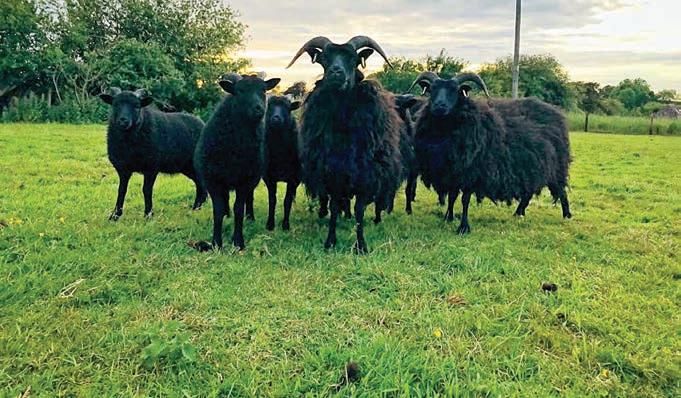
When I arrive in the office, I’ll check my emails. My days are normally split 50-50 between time in the office and time out and about meeting clients. I am heavily involved in valuation and planning work as well as grant applications, utilities work, compensation claims, land sales and recently a lot of jobs involving rights of way.

I head off to my first appointment – a planning application on a curtilage listed outbuilding that a client wishes to convert to holiday lets. My visit involves inspecting the building and the site to assess how access, construction, visual outlooks and the proposed plans might be deemed to impact the Grade II listed farmhouse next door.
Then I head west to carry out a probate valuation for a dairy farm on the coast. I sit down with my client to make sure I have all the details I need before inspecting the farmhouse, farm buildings, land and stock.
Dorset born and bred, I thoroughly enjoy working in the area where I grew up
Back in the office for lunch. After a busy morning, I find myself with an afternoon at my desk. This gives me a chance to squeeze in a meeting with our building surveying team, also based in Wimborne, to get their advice on the best possible layout for the proposed holiday let in my first meeting of the day. Once I have their thoughts on a sensitive conversion, I start drafting my covering letter and compiling the rest of the planning application.
:The phone rings with a gentleman who has a two-acre parcel of land on the outskirts of Wimborne that he would like to sell. As he is lucky enough to have a couple of brick barns on the plot, I advise him on the potential to secure outline planning for a residential unit which would likely give him the highest increase in value at the least expense to himself, and recommend an auction sale in the spring. I arrange to go out to see the site for an appraisal the following week.
:One last check of my emails then I’m off to a local firm of accountants for a continuing professional development (CPD) event on farm accounts. We are in an industry that prides itself on working collaboratively with all manner of professional advisers – accountants, solicitors and banks managers. Our CPD is a way of getting to know other professionals whose areas of work overlap our own, and from whom we can learn in order to best advise our clients.
Finally, I am back in the car and on my way home to Lulworth. As soon as I get in, I’ll be lighting the woodburner and organising dinner.
Tess Tidman qualified in 2017 and works from our Wimborne officeTessa Tidman
Surveyor Wimborne
If you’ve found yourself on the A35 between Dorchester and Bridport recently you might have wondered what on earth is being built now.
However, you can breathe a sigh of relief that this eyesore is temporary and part of the National Grid’s Visual Impact Provision (NGVIP) project.
NGVIP makes use of a fund made available by Ofgem and creates an opportunity to enhance the West Dorset landscape and transform the views from the Hardy Monument and the South Dorset Ridgeway.
It will achieve this by removing 22 unsightly electricity pylons between Winterbourne Abbas and Friar Waddon, replacing them with 9km of underground cables and leaving an unblemished skyline.
This is the first time a project of this kind has been undertaken anywhere in the world for the sole benefit of improving the surrounding landscape.
Of course, this all sounds simple enough, but it is in fact a major engineering challenge made trickier by current land uses, ecological impact, the topography of the countryside and archaeological interest.
I have been involved with the project since the early planning stages of the scheme, working on behalf of seven of the landowners who have been, or will be, affected by the scheme and have seen first-hand some of the challenges the venture has faced.

Dorset has a historically rich landscape and the preservation of archaeological interest has been paramount. More than 147 excavation trenches have been dug and a burial chamber of seven mid-6th century bodies were discovered on a client’s farm, as well as evidence of Bronze Age barrows, a potential Roman settlement and medieval cemetery, so far.
Moving on to the 21st century, the construction of the scheme has impacted on other aspects of farming and rural businesses where negotiations and agreements have had to be made, including negative impacts on a client’s poultry farm, agreeing bio security measures for a pig unit, the knock-on effects to a campsite business, and disruption as footpaths have been diverted to private land.
The engineering itself is also vastly different from most new underground cables that some landowners may have experienced with easements in the past. However, as usual the land will be fully reinstated, with the landowner receiving negotiated compensation and able to resume farming practice once the cables are installed.


A lot of consideration has been given to the environmental impact of the scheme and the Reconnecting the Ridgeway Project was awarded £400,000 from the Landscape Enhancement Initiative (an important part of NGVIP). With this they will be laying hedges, planting an orchard, creating a daffodil nursery, restoring boundary features and creating wildlife ponds to encourage biodiversity.
Initial work on this scheme started back in 2015 and the project will be completed in 2022 at a total cost of £116m.
Let’s hope once the project is finalised many of us can enjoy the ‘unblemished’ landscape and appreciate the work which is being done to restore and enhance our environment.


Will
This is the first time a project of this kind has been undertaken for the sole benefit of improving the landscape
Will Wallis from our Dorchester
reveals why Dorset is getting VIP treatment

Pupils at Damers First School in Poundbury have become eco-warriors. Led by Edd Moore – year 3 teacher and Eco Co-ordinator – the children have formed the Eco Crew and they’re on a mission to make Dorchester plastic free.
Damers achieved ‘Plastic Free Schools’ status in May 2018 and now the Eco Crew has its sights set on the town. They’ve got off to an impressive start.
So far, the Eco Crew has been interviewed by the BBC, visited London to petition Michael Gove, and presented at various meetings to encourage businesses to be plastic free.
By writing letters, giving presentations to influential groups, and attending shows, farmers’ markets and fairs, they have persuaded almost every school in Dorchester and more than 80 businesses to go plastic free.
The Eco Crew is targeting single use plastic, and is asking businesses across Dorchester to eradicate three single use items within their premises. This could be as simple as no longer stocking plastic cups and moving to reusable bottles.
The Eco Crew has championed eco products including ‘waxtastic’ – an alternative to clingfilm – at a number of shows. They also take in recycling from local businesses in order to fund sustainable projects at the school, and have written and performed a song about being plastic free.
Thanks to the efforts of the Eco Crew, shops and boutiques are replacing plastic bags with paper ones, and using wooden hangers. Those in the hospitality trade are providing guests with reusable, branded water bottles, supplying loose tea rather than tea bags, and offering toiletries in tins or paper packaging.
All stress the importance of putting pressure on their suppliers to make the necessary switch away from plastic.

Together with key organisations and businesses in the town, the Eco Crew has put in place a plastic free plan. The objectives include setting up a community-led
steering group; instigating the Surfers Against Sewage plastic free schools education programme; getting local council commitment, and working with local businesses, organisations and community groups to spread the word and minimise the amount of disposable plastics.
As a result of Damers’ work, and with support from Dorset Council, Dorchester Town Council, Dorchester BID (Business Investment District), Litter Free Dorset, Duchy of Cornwall, Sir Oliver Letwin, local WI Groups and the Dorchester Lions, Dorchester has been awarded ‘Plastic Free Community Approved’ status by Surfers Against Sewage.
The award recognises the work done to reduce the impact of single use plastic on the environment.
Dorchester is the third location in Dorset to receive this accolade and the Eco Crew is the first group of children to lead such a campaign.
There are some great initiatives that are being driven by youngsters throughout our region, and Symonds & Sampson will be engaging with these groups to make sure we are supporting the next generation.
 Jan Merriott BSc (Estate Management) MRICS Commercial Surveyor Dorchester jmerriott@symondsandsampson.co.uk 01305 261008
Jan Merriott BSc (Estate Management) MRICS Commercial Surveyor Dorchester jmerriott@symondsandsampson.co.uk 01305 261008
The Eco Crew has persuaded more than 80 businesses to go plastic free
Symonds & Sampson takes great pride in providing the highest level of service in the management of residential and commercial assets. We have established strong working relationships with stakeholders across the board, and are well positioned to not only protect our clients’ property interests, but to maximise property and asset values through our proactive and focused management approach.
We believe robust landlord and tenant relationships are the foundation of successful property management and underpin commercial property values. As a firm, we offer tailored day-today management services of commercial property assets on behalf of our clients.
A key principle of our management service is focused on ensuring commercially let premises remain occupied in accordance with their respective leases, and fully compliant with prevailing industry legislation – ensuring our clients’ position and property interests are safeguarded at all times.
We are also able to provide professional advice in relation to the preparation and administration of service charges for multilet commercial property assets. We work in close collaboration with solicitors and other legal representatives to assist in the structuring of commercial leases, and develop property-specific management strategies for and on behalf of our clients.


Areas we cover include commercial lease advisory, client accounting and financial administration services, property inspections, market rent/valuation appraisals, and development consultancy.
Leasehold properties such as flats are those where a lease has been granted for a period of time by the freehold owner. Sounds simple? It sounds simple but leasehold properties come with a number of management responsibilities that can often be overlooked and, if left unmanaged, result in breaches of insurers’ and/or freeholders’ requirements. This can expose leaseholders to potential negligence liabilities – an unwanted management headache for all concerned!
Symonds & Sampson offer a range of bespoke services for residential management companies – ensuring residential buildings remain compliant with prevailing legislation, and continue to be safe and pleasant environments for residents.
We are able to take on the day-to-day administration of all property management-related matters, including management accounting, overseeing service contracts and maintenance works, administering insurance, and working closely with new and established resident directors and/or management committees to ensure positions are safeguarded and peace of mind.
We are also well equipped to provide professional valuation advice and support in respect of leasehold extensions, in accordance with prevailing Leasehold Reform Act legislation.

To discuss the management of your commercial property assets, or if you are looking for help with any residential management matters, do not hesitate to contact us.

Need help managing your residential or commercial assets? George Rogers explains how Symonds & Sampson can make life easierGeorge Rogers BSc MRICS Commercial Surveyor Yeovil grogers@symondsandsampson.co.uk 01935 382904
We are able to take on the day-to-day administration of all property managementrelated matters
T he professions, and certainly the solicitors’ profession, have always tended to be places of grey uniformity. The livery for male solicitors was always sober suits and ties, but it now seems to have given way to a dumbed-down drabness, and largely tieless. This is a pity.
All the more reason, therefore, to uphold traditional standards and even better to celebrate individuality, style and a bit of colour.
Fancy waistcoats for auctioneers and land agents should be encouraged, as should ties for solicitors; especially ties aligned east-west rather than north-south, and of course self-tied.
A word of advice for the young professional: always try to stand out from the herd. Be egregious. That way it’s easier to get known. As you build your career and your reputation, it is so much easier to become well known if you have some eccentricity or difference which sets you apart.
Clip-on bow ties are an abomination; anyone found wearing one should be sent to the Tower


Of course, it’s easy enough for a bloke to adopt a dress style which gives him a trademark, so to speak; but for the lady professional it is more difficult. The best advice would probably be to continue to dress with style, and be yourself.
Bow ties should always be self-tied (it is just like tying a shoelace). Clip-on bow ties are an abomination; anyone found wearing one should be sent to the Tower.

Monocles, spats, two-toned shoes – all these have their moments and their adherents, but colourful waistcoats for land agents are as unusually welcome as bright bow ties for rural solicitors.
Your correspondent is an inveterate bow tie wearer. Many is the time my wife has been asked by farming clients whether I wear one at home and, if so, whether I am still wearing it when I come to bed [that’s quite enough of that, Editor].
I have approximately 60 bow ties hanging on my wardrobe door, and am never known to wear the same one two days running.
The hinterland of any professional is important in terms of getting known and also in terms of building a relationship with the client. Always include a list of your interests at the bottom of the CV, and the more unusual the better. These will always be useful in interviews.
For some, the particular interest may be sailing or Sudoku, horses or hockey (in my case, it’s things as eclectic as collecting books, conducting military tours, baroque music, G&S patter songs, ley lines, county cricket, and cryptic crosswords). But whatever it is, it’s important to show there is more to you than just work.
If anyone is inspired by this article to adopt the elegance of the bow tie, it will not have been written in vain. Lessons in tying the bow tie are available; I charge in guineas and/or cognac.
Jonathan Cheal Solicitor – Agriculture jonathan.cheal@mogersdrewett.com
Jonathan Cheal, agricultural solicitor at Mogers Drewett, champions the need for individuality in the professions
Jonathan Cheall’s advice to women is to “dress with style and be yourself” but what does this mean in practice? Today, the majority of women are in employment and more than ever are working in what was thought of as traditionally male professions. Where does this leave women, who do not have the uniform of a suit in its different guises?
Debrett’s suggests for working women: “A neat, tailored look is best for business … and smart accessories.”
many of us wear as we visit clients on farms, tackling barbed wire fences in all weathers.
As we experience hotter summers, our work clothing often struggles to keep pace. If you can wear it at the beach or in a nightclub it will probably not impress the clients or put them at ease. We are all brand ambassadors for both our companies and ourselves. The overall impression we leave with clients may affect their decision on whom to employ.
Focusing on a few classic tailored pieces, possibly with a twist, can be a wise investment
Thank goodness we have left the era of power dressing, high heels, full make-up and corporate dress codes banning trousers.
There is endless advice from the press and influencers on the internet how to create a capsule wardrobe, especially on a limited budget or when you are starting your career. Focusing on a few classic tailored pieces, possibly with a twist, can be a wise investment.
Despite the well-worn phrase “don’t judge a book by its cover”, humans are visual creatures and we all make unconscious judgments within a short time of meeting somebody. There is truth in “you never get a second chance to make a first impression”.
Dressing well is a form of good manners. For both men and women, personal presentation combined with wearing appropriate clean and pressed clothes is essential.
Wearing unpolished shoes speaks volumes – making an effort shows respect. According to Marilyn Monroe: “Give a girl the right shoes and she can conquer the world”, although I don’t imagine she was referring to the wellies and sensible shoes
Women have the advantage of a more flexible dress code and the potential to express their individuality. We recognise many successful women by their unique signature style. They know who they are, what suits them and what they want to say about themselves.

As a child I have vivid memories of my francophone grandmother’s regular exhortations on manners, deportment and appearance, as well as avoiding the major failing of not being “bien dans sa peau”.

This elegant, adventurous woman had lived all over the world and was at ease in any situation. At the time I didn’t understand her maxim of stand straight, shoulders back, look people in the eye and shake their hand. She knew that if you look and feel good by being true to yourself, it communicates confidence.
Or as fashion designer Rachel Zoe puts it: “Style is a way to say who you are without having to speak.”
Struggling with what to wear in the workplace? Our Axminster style maven
Angela Gillibrand has tips for the well-dressed womanAngela Gillibrand Farms and Rural Axminster agillibrand@symondsandsampson.co.uk 01297 33122


Not many people know about The Arts Society. But it’s big, with more than 90,000 members in over 380 local societies, and we are lucky enough to have one right here in West Dorset.
In 1968 a group of eight local arts and antiques groups came together to form what was then the National Association of Decorative and Fine Arts Societies, catchily shortened to NADFAS. A young woman named Patricia Fay had spearheaded this, later receiving an OBE in recognition of her vision.
The monthly lectures are now taking place at the Town Hall, Bridport, meeting on the third Thursday of the month
The speakers’ knowledge and enthusiasm is informative and infectious, often opening up new areas of interest. You don’t need to have knowledge or even an interest in the subject to enjoy the presentations. In fact it is often the case that the lectures you think will interest you least are a real surprise. My favourite a couple of seasons ago was on the early 20th century fashion designer, Mariano Fortuny – and I thought I wasn’t the least bit interested in fashion.
Sadly, Patricia died aged 46 but a fund was established in her memory to provide grants to three areas: young arts; regional and local museums and galleries; and skills development.
Just before the 50th anniversary celebrations, NADFAS became The Arts Society and we became The Arts Society West Dorset. The name was the only thing that changed; the society continues to celebrate and promote all aspects of arts, welcoming everyone to hear about them in all their fascinating diversity.
The Arts Society works on the principle that the arts enrich our lives and bring people together who have an interest in all things artistic. It’s remit is vast, encompassing among others things, literature, gardens, fashion, architecture, painting, sculpture, art history, glass, jewellery, silver and gold. It provides lectures, workshops and visits not only locally and nationally, but also internationally.
The West Dorset branch began in 1988, helped into life by one of Patricia Fay’s original founding members, Pamela Charlton, who had moved to the area. As well as a season of excellent lectures, the local committee also organises special interest days and outings to exhibitions, with occasional longer trips away if there is enough interest.
Locally we draw on The Arts Society’s pool of speakers, many of whom are published or curators of notable exhibitions. Recently this included Antiques Roadshow’s Paul Atterbury and Ian Pickford.
We have started this season in a new, more central location. The monthly lectures are now taking place at the Town Hall, Bridport, meeting on the third Thursday of the month.
We hope the central location will mean that people can meet for lunch in one of the great local cafes and pubs in Bridport, and of course parking is available close by. Around 50 members attend each month and visitors are always welcome.
The full programme and membership details can be found on the website at www.taswestdorset.org.uk
Fees are £50 for individual and £85 for joint membership, including membership of the national organisation and its quarterly magazine.
Visitors are welcome at a cost of £7.50 per lecture
To find out more: Telephone or email: Mrs Sandy Lovelock Membership Secretary
The Arts Society West Dorset Tel. 01305 848390 Email. info@taswestdorset.org.uk Web: taswestdorset.org.uk

If you enjoy hearing about all aspects of arts – from fashion and literature to paintings and architecture – The Arts Society West Dorset could be the place for you
Planning permissions will always be granted subject to conditions which are used to mitigate any adverse effects of a proposed development, and which provide the Local Planning Authority (LPA) with the framework to ensure the development is undertaken in accordance with the plans.
Planning obligations or S106 agreements, on the other hand, are legally binding agreements between the property owner and the LPA, which run with the land and therefore impact future owners as well as current ones.
In rural planning, S106 agreements are commonly found in association with permission granted for agricultural workers’ dwellings. These consents will be subject to the standard planning condition restricting occupation to someone currently or previously employed in agriculture. On top of this, LPAs also insisted the applicants enter into a S106 which ties the whole property together and prevents the ability to sell any part away from the whole, or to let the property separately. This in turn has a negative impact on values.
The most recent National Planning Policy Framework (NPPF), dated February 2019, offers some clarity on the use and application of planning conditions and obligations. It clearly states that planning obligations (S106s) should only be used where it is not possible to address unacceptable impacts through a planning condition and that the ‘doubling up’ of conditions and obligations is no longer acceptable.
As a result of this, we have been successful in securing the removal of the S106 agreement for a number of clients.

The removal of the S106 does not remove the agricultural occupancy condition but it does lift the restriction over the whole property, meaning that owners have the freedom to sell or let part of their property without the need to have to revert to the LPA.
In practical terms this also results in an uplift of value and removes potential difficulties when charging property as security for a mortgage.
S52 agreements are the predecessor of S106 agreements. For anyone who still has a S52 agreement in place, these are treated in the same way as S106s and can therefore be cancelled following an application to the local planning authority.


The old West Dorset DC Local Plan contains policy SUS3 which deals with the change of use of redundant buildings to dwellings. The only instances where such a change of use was acceptable under this policy was where the new dwelling could be tied to the farmhouse by way of a S106 agreement.
This flew in the face of the NPPF and, after much discussion with the planning department, the requirement has been dropped – meaning it is now possible to secure planning for change of use of agricultural buildings to unrestricted dwellings in certain circumstances.
This is of particular relevance to those within Areas of Outstanding Natural Beauty which are unable to take advantage of Class Q permitted development rules.
Planning conditions can be a burden. Don’t allow your rural property to be unreasonably encumbered
We have been successful in securing the removal of the S106 agreement for a number of clientsEdward
Flowers are always evolving with the seasons but recently the floral industry itself has been one of revolution.
The rise of social media has transformed the way brides find both their florists and their floral aspirations for their weddings. Floral designers now attract social media followings in their thousands, many initial enquiries coming through platforms such as Instagram or Facebook.

Ten years ago, the emphasis was on bricks and mortar shops to mark your presence. Now, new florists are stylists with an Instagram account as a shopfront. The ease with which new florists can establish themselves has made the floristry industry a much more attractive career path. Every week I receive requests for work experience or freelancing from numerous start-ups.
This leads us on to the rise of the floral installation. We have seen a dramatic increase in stand-alone installations, focusing a budget in one area, rather than lots of smaller arrangements. Think hanging floral displays, cascading staircases and impactful entrances. These have been both encouraged by the Pinterest imagery and public events such as Harry and Meghan’s wedding.
Enabled by the community of florists over Instagram, there is now a drive towards eco-friendly floristry. The movement away from floral foam to water-sourced mechanics in all structures is crucial. As is the use of recyclable vessels such as glass rather than disposable plastics trays. Flowers being wrapped in paper rather than plastic sleeves are also helping to improve the industry’s ecological footprint.

As important is the provenance of the flowers. There are British flower farms popping up all over the country, alongside sourcing flowers from reputable wholesalers, and Fair Trade. I, like many florists, have a little cutting patch, where l produce a few blooms which don’t travel well.
Pinterest is overflowing with floral imagery; however, this can be described as a double-edged sword, some claiming it stifles creativity, providing an encouragement to replicate ideas, rather than promoting innovation, and setting unrealistic expectations.
However, it is the most wonderful starting point to understand likes and dislikes in flowers, building up colour palettes and inspiration for floral installations.
Changes are usually seen most quickly in London, with top florists being at the forefront of the huge installations or new foam-free mechanics, yet with Dorset and Somerset now a major wedding venue destination, these hot topics are on our doorstep.

The rise of the instagram florist, the popularity of huge installations, and the push for a greener industry. Caroline Redpath hails the floral revolutionCaroline can be found on Instagram @fleur_provocateur, or her website www.fleurprovocateur.co.uk Photographs by Katharine Davies
We specialise in bringing barn conversion projects to the property market. Having just completed her own, Annabel Douglas shares her top tips
Seeing your project evolve is rewarding but the whole build process is very fluid, with constant compromises and decisions being required. Unless you employ a project manager, prepare to get very involved. Know your strengths and weaknesses, and get help if necessary.
Electricity, water and drainage – these should be your first consideration. If you can access mains services, life will be so much easier. Installation can be costly and a project in itself.
Phone lines are another issue. I am yet to get a landline due to technical difficulties with the supplier being unable to locate my property! Thank goodness for mobiles.
Assuming planning has been secured, it is important to be aware of the Community Infrastructure Levy which some councils apply to barn conversions. Self-build exemptions are available but must be applied for prior to commencing work –check with your council.

We’re talking health and safety, asbestos surveys and insurance. Ensure you are up to speed with requirements. You can apply to your council direct or employ a firm to oversee building regulations for you. Look into both options as they vary in cost and method.
Unfortunately, rural crime is prevalent. I was reminded of this the first week of my build when an extension cable was stolen one night. After this, everything was either locked up or tied down. Materials and equipment are expensive; you don’t want to have to replace them.
Personal recommendations are very important. Choose carefully and expect to wait for the best people to be available.
I love my barn’s bespoke features – the green oak beams, sliding outer door, limestone floor – but each part made the build more complicated and costly.
It is important to ensure the design is practical. My metal roof looks great, but is noisy when it rains. And my brother was right when he said oak bi-fold doors would be awkward due to the wood warping.
Only go bespoke where it is really necessary or makes a difference. My kitchen was from a large DIY retailer but the bespoke worktop makes people think it is high end.
Check any landscaping planning conditions and make sure they are adhered to; then prepare for another project. Colour chart for gravel, anyone?
You currently only have to pay 5% VAT on certain items relating to your barn conversion. It is therefore essential to gather all receipts and claim within the designated timeframe as this can be a large saving.
Unless you are really organised and/ or lucky, you will require more than originally planned. Make sure you have a contingency fund.
Was it hard work? Yes – I’m not going to lie! Prepare yourself for a challenging ride full of extreme highs and lows. Was it worth it? Definitely yes. I love my barn and the fact every element reflects my taste. It’s my own mini ‘Grand Design’ in the Dorset countryside, with room for a pony.
Annabel Douglas MRICS FAAV Planning/Rural Surveyor Bridport adouglas@symondsandsampson.co.uk 01308 422092
Vampires were a childhood fear so I have been rather unlucky to be woken up in three different houses with a bat flying around my bedroom! Despite screaming hysterically with a duvet over my head, I am pleased to report none of them bit me and, as a result, I am now rather fond of bats and find them quite fascinating.
In the UK there are 18 different species of bat. Bats are nocturnal and use sound to navigate to detect obstacles in flight, find their way into roosts and forage for food – a trick called echolocation.
Bats and their roosts are protected by law. It is illegal to damage, destroy or disturb any bats or roosts without official consent. A roost is “any place that a wild bat uses for shelter or protection and the roost is protected whether bats are present or not”.
Bats and other protected species should be considered when undertaking development work. Depending on the type of development proposed, the local council will require an ecology survey to be undertaken by a qualified licensed environmental consultant.

Surveys should be carried out at the optimum time of year when species are most active. If species are located, it may be necessary to undertake further surveys. The consultant will then prepare a report and biodiversity mitigation plan which will suggest suitable measures; this will then be agreed by the council. For bats these could include bat boxes, incorporation of existing roosts into new buildings and bat barns/houses.

Not all species are fortunate enough to enjoy legal protection. West European Hedgehogs are listed as a UK Biodiversity Action Plan (BAP) priority species as there has been a noticeable decline in hedgehog numbers in recent years. The BAP list is still used to inform wildlife priorities at various levels of governance across the UK, although it has been superseded.
While developers are obliged to provide mitigation measures for protected species, it is important we try to give all nature a home, protected or otherwise.
Bat boxes and hedgehog houses make a nice addition to any outdoor space and there are a range of designs available. Sadly we can’t guarantee a swift ‘sale’ to the first bat or hedgehog. As with all real estate, location, location, location is vitally important and, just like humans, animals can be very picky!

 Annabel
Annabel
Bats and other protected species may affect your planning application.
Annabel Douglas explains how to minimise disruption
which need to be
in the
Have you ever considered donning a stylish yet practical beekeeping suit, lighting up a smoker and harvesting honey? Well, you should!


There is nothing more satisfying than keeping your own bees, but to a novice it can seem daunting. Panic not! There is a wealth of information and help out there.
Across the UK, there is a network of beekeeping associations ready to help you kick start your hobby. In Dorset alone there are five associations – Dorchester and Weymouth, Blandford and Sturminster Newton, East Dorset, Sherborne and West Dorset – and they are all happy to help.
If you’ve decided beekeeping is something you’d like to try, then first you must determine where to locate your hive. Bee hives can be found in all sorts of locations, from fields to rooftops, but there are a few key considerations to ensure your bees are happy and productive – giving them enough clearance to exit and enter the hive, keeping them in dappled sunlight to avoid overheating in summer, and of course ensuring you can easily access it to harvest your honey.
Once you have found the perfect spot, you will need to kit yourself out with the necessary tools for the job. This can be expensive, but you can pick up some second hand bargains at local auctions or online.
The essentials include:
• Suit – don’t forget gloves
• Hive and frames
• Smoker
• A hive tool
Once you have all the kit, you’ll need some bees. It is possible to set up a bait hive during the spring, but a safer option would be to order a nucleus from a reputable supplier. Bees from Buckfast Abbey in Devon are known for being happy and docile.
An alternative and cheaper option is to add your name to your local beekeeping association’s swarm list. During the swarming season (May to July), they will receive numerous calls from members of the public asking them to remove rogue swarms. At this point, they will call those members who have registered for a swarm and deliver it to your door. A word of caution – a colony that has swarmed can be more aggressive and difficult to handle for a beginner.
Once you have your bees, you will have to wait a little before you can reap the rewards. As such, you shouldn’t take any honey in the first year as the colony will need food for the coming winter. Bees will cover a wide area to gather pollen – up to three miles. So your surroundings will have a direct impact on flavour, texture and colour.
Now, for the most exciting part – harvesting that honey. A word of advice: your kitchen might get sticky. If you’re lucky enough to have runny honey, you can pop the frames into the honey extractor and voila! The honey can be easily decanted into jars ready to eat.
If, however, your bees have a taste for heather, you may have to eat the honey straight off the comb as it will be too thick to remove from your frames.
Breakfast will never be the same again!
Tessa Tidman MRICS & Nick Rymer MRICS FAAV Rural Surveyors Wimborne ttidman@symondsandsampson.co.uk nrymer@@symondsandsampson.co.ukBees from Buckfast Abbey in Devon are known for being happy and docile
Tessa Tidman and Nick Rymer enjoy the buzz of beekeeping
In 2018, my family and I purchased our ‘forever home’ at Affpuddle. The property had a gently sloping lawn which appeared to be mainly formed of moss, weed and ivy. It was evident that drastic action was required to bring it back to life. My wife bravely suggested pigs were the answer; our lives have never been the same.
When I was growing up, I was surrounded by arable farms and horses – thereby hands-on experience with livestock was quite limited.

Having undertaken what we thought was an adequate job of fencing the front lawn with old equine electric tape, we purchased our first five pigs – rare breed Mangalitsa, a Hungarian pig which is part boar and resembles a cross between a sheep and a pig with a coarse but very curly coat.

Within 10 minutes of arriving, our five little pigs proved that old equine electric tape was ineffective against their strong will and thick coats. Passing traffic would have seen my wife, myself, our two children and Duncan Joynt (a local contractor and farmer) dashing about trying to herd these speedy woollen tanks back into their makeshift paddock. New electric fencing tape was required.
Not content with just five Mangalitsa pigs, we then acquired three Oxford Sandy and Blacks to join the team, who settled in relatively quickly once the pecking order was established.
After two months, the moss-covered lawn was more akin to a very badly ploughed field. As a result, a portion of one of the fields was professionally fenced out to provide a permanent pig paddock. This seemed ideal; “no getting out of there” we naively said.
Unfortunately it appears the paddock was not sufficiently stockproof, as a message from one of my colleagues proved: “A-J, we’ve had a call from your neighbour to say pigs are currently running around his garden.”
A frantic dash home revealed that the pigs had done the limbo under part of an old fence. My neighbour politely pointed out that pigs particularly liked rose bushes!
We have endured a further two or three escape attempts by these fluffy bullets. They appear to have speed and stamina to put a serious runner to shame. Sadly, I do not! As a result, four of the chief troublemakers are now in piggy heaven.
We have now taken on five Tangalitsas. This is a cross between Mangalitsa and Tamworth and gives a very attractive ginger pig which appears to be even more determined to escape. Ours can extract themselves from a field through an apparently nonexistent hole.
Having now reached the end of our first summer at Affpuddle, we are branching out further as my wife kindly gave me three Ruby Red Devon cows which will bring the sum total of animals (including chickens, dogs, pigs and cattle) on the holding to roughly 130 legs.
In January 2020 one of our Mangalitsa’s gave birth to four piglets, the father being our Tangalitsa boar, so this number will continue to rise, I am sure.
There is one particular phrase that Duncan Joynt said to me when we were discussing breeds of cattle and pigs: “There’s a reason they are rare breeds.”
A-J Monro is a respected Partner of the firm, manages two of our offices and is a star of the agricultural valuers scene – but he’s being put to the test by his runaway pigs
A-J Monro MRICS FAAV Partner Wimborne amonro@symondsandsampson.co.uk 01202 843190
A-J, we’ve had a call from your neighbour to say pigs are currently running around his garden
Self-Invested Personal Pensions (SIPPs) and Small Self-Administered Schemes (SSASs) are Governmentapproved pension schemes which enable individuals and companies to manage their own investments within their pension fund.
They offer a range of investment opportunities, including commercial property and land holdings, and may even borrow to fund those investments.
Commercial real estate such as retail, industrial or office buildings are often held within pension funds to ‘hedge’ against inflation, helping the value of your pension pot and retirement income keep pace with the rising costs of living.
beneficiary on death completely free of IHT. In certain circumstances there could also be Income Tax benefits for your beneficiaries when they come to take the pension.”
As with any tax planning, your individual circumstances need to be carefully considered. However, for a taxpayer with the right set of circumstances, holding property in a SIPP or SSAS can be very beneficial indeed.
Old Mill provides administration and accounting for pension schemes and is able to offer technical and investment advice.
Holding property in a Self-Invested Pension could help to reduce your Inheritance Tax exposure


The advantages of holding commercial property in your pension can go well beyond hedging against inflation, as Peter Noble, rural tax adviser at Old Mill, explains: “For commercial property owners looking to build a pension pot or to preserve the value of their property across multiple generations, SIPPs and SASSs can be a great addition to the tax planning toolkit.”
Some of the ongoing tax benefits are well known:
• Rental income and capital growth of assets in a pension fund are free from both Income and Capital Gains Tax (CGT).
• Better still, where the pension’s assets are used in your own business, the market rent paid to the pension fund is allowable as a deduction against your business profits. Holding property in a Self-Invested Pension could also help to reduce your Inheritance Tax (IHT) exposure.
“Let’s say that you hold a property in your estate that is not expected to qualify for IHT reliefs,” explains Peter. “Your executors could face an IHT charge of up to 40% of the property’s value at your date of death. Gifting the property to a family member or trust could help to reduce that IHT charge, possibly even to nil, but are you happy to lose control of the property?”
Peter continues, “One alternative would be to hold the property in a SIPP or SSAS. This would allow you to retain control, to benefit from the rental income over the course of your lifetime, and to pass the pension fund to a nominated
Symonds & Sampson are able to assist in providing formal Red Book valuations for both SIPP and SSAS purposes as well as other tax-related matters. In addition, we offer a number of other commercial property services including:
• Commercial Agency
• Commercial Property Management
• Landlord and Tenant Matters


• Commercial Lease Advisory

Inheriting a country estate may sound like a dream come true, but what about the upkeep? The owners of Stock Gaylard found they had to get creative
Andy and Josie Langmead and their three children moved to Stock Gaylard Estate near Kings Stag in 2002 when it passed to them from Josie’s step-grandfather, Colonel Yeatman.
From just a handful of stalls, the event has grown to be quite the show
The house dates back 300 years and the parish church within the grounds to the 13th century. The estate itself is noted in history well before the 15th century and is now some 1,800 acres of farmland, woodland and the deer park, with much of it designated a Site of Scientific Interest (SSI).
The Langmeads’ main ethos is the preservation and conservation of the grounds and its features, as well as the historic property that comes with it. This is not a cheap business and so their diversification businesses were born.
Alongside the more usual means of revenue, including property rentals and farm tenancies, is the Oak Fair which Andy introduced 15 years ago.
From just a handful of stalls, the event has grown to be quite the show. In 2019, around 11,000 people flowed through the gates over the two days. With over 250 exhibitors, arena shows including heavy horses, falconry and lumber jacking, a fabulous food market, tree climbing, archery and axe throwing, it is becoming a popular destination.


The fair was an idea borne out of Andy’s passion for conservation and the remarkable Crusader Oak which lies at the heart of the fair and is believed to be over 700 years old, named after the Crusader buried in the church at around the same time. The fair also features the ancient Oak Avenue that runs through the park.
While juggling the growing fair, the Langmeads also decided to establish a glamping business and the estate now has four off-grid glamping sites, all at least half a mile from each other so guests are left totally undisturbed.

Uniquely, they offer private sites for large groups with a large communal area, proper kitchen facilities and private bathroom just for the group. All the sites run totally on solar power for the lights, fridges and other electricals; gas bottles provide cooking and instantly warm showers, but guests’ favourite is the woodfired open-air bath.
As if this wasn’t enough, the summer of 2019 saw the Langmeads purchase and renovate The Green Man pub in Kings Stag, headed up by son, Jack. The pub not only gives glampers a lovely local, but can be used as an outlet for some of the farm’s meat and venison from the deer park.

The estate’s latest plan is to hold an Obstacle Mud Run in spring 2020 so watch this space!
Immy Robinson office@stockgaylard.com

Expert guidance makes all the difference when it comes to maximising planning opportunities and our qualified staff are ready to help
Class Q permitted development enables a simplified approach to converting agricultural buildings to dwellings, an opportunity that many farmers have capitalised on. But have you ever come across Class R?

Class R is the lesser known alternative that enables the conversion of qualifying agricultural buildings to flexible commercial use, including Class A1 (shops), Class A2 (financial and professional services), Class A3 (restaurants and cafés), Class B1 (business), Class B8 (storage or distribution), Class C1 (hotels) and Class D2 (assembly and leisure).
Under Class R, the building must have been used solely for the purpose of agriculture on an established agricultural unit since 3 July 2012, or when it was last in use. Any building brought into use after this date will only qualify if it has been maintained in that use for a minimum of 10 years.
The cumulative floor space to be converted must not exceed 500m2. The building must not be used as a military explosives storage area or safety hazard area; it must not be listed, and it must not be a scheduled monument.
Finally, depending on the size of the building you wish to convert, the 56-day notice to establish if prior approval is required may not always be needed.
It must be noted that Class R only allows for the ‘change of use’ element and does not cover any operational development required to convert a building, so planning permission is required if you need to make any alterations to the external appearance of the unit.
So why convert a farm building under Class R and not Class Q? There is one key difference: the ability to utilise your Class R permitted development rights in designated areas such as AONB and National Parks where the use of Class Q is prohibited.
There are, of course, other factors such as location, local demand and financial issues when considering the route of Class R. However, in a time of uncertainty in agriculture, it is important to identify opportunities to maximise the potential in an asset and explore alternative – potentially lucrative –income streams.
The aim of the General Permitted Development Order 2015 (GPDO) – otherwise referred to as permitted development – is to speed up the planning process and ultimately deliver more housing to the UK’s under-supplied residential market.

The GPDO lists a number of conditions which a proposed development must fulfil, and gives local authorities a say on some aspects of design and siting. However, because of the speed in which a local planning authority must respond, usually 30 days, and the legislative powers which permitted development provides to the developer, this can be a challenge.
It is the responsibility of local government, developers and real estate professionals to produce buildings which are attractive and form the basis of a home.
I am pleased to say that Symonds & Sampson has been involved in a number of projects which seek to promote a good standard of living, such as Court Ash in Yeovil which saw an unused office building converted under the GPDO into contemporary apartments, offering a variety of accommodation which is both affordable and high quality.
It shows that permitted development can provide good quality housing by repurposing old and tired buildings.
 Annie
Annie
 t Winter by Annie Taylor, www.annie-taylor.com
t Winter by Annie Taylor, www.annie-taylor.com
We delve into the history of the picture postcard, the delights of the daily commute, and the story behind Sherborne’s Pageant Gardens. There’s a shout-out for heritage buildings, the joy of fishing, and the milestones that mark our highways and byways. We discover what it takes to open your garden for charity, how S&S supported our troops in WWI, and conduct a straw poll on thatch. There’s food for thought in Weymouth, military memories in Fontmell Magna and Wellington, and a round-up of smart home technology. We review another good year for property sales, and forecast lucrative opportunities for investors in commercial property. Our lettings team consider the merits of residential and holiday lets, give us an insight into a day in the life of a property inspector, and reveal their top picks from a bumper crop of lettings.

It is some years since the BBC would broadcast an SOS message, after the shipping forecast and before the news, asking someone to contact their relative usually because someone was gravely ill.
The person would invariably be on holiday in Britain or France where the longwave signal could be picked up.
Now with constant contact through mobile phones and emails there is no need for these irregular BBC messages.
I was thinking about this when looking through the rack of postcards on holiday in Cornwall because until recently this would have been the most popular way of sending a written message to family and friends, and I wondered when it started.
Postcard collectors, or deltiologists, can tell you it began in 1870 when the Post Office produced plain cards with a stamp, but it took 14 years for the first picture postcard to appear.
Having been brought up in the Carry On film era, my eyes are drawn to the saucy postcards. These began distribution in the 1930s and at their peak 16 million were sold in a year.

Look around your local house clearance auction or flea market and you are bound to see postcards
They were often a little tacky, relying on the innuendo involving big-busted ladies and put-upon husbands. The Government of the day, concerned about falling moral standards, cracked down on the rudest and it was not until the 1960s, possibly because Hattie Jacques and Sid James and their double entendres were popular at the cinema, that they made a revival.
Many saucy postcards are, naturally, not appropriate today but should we take them for what they are? Is it part of our national history and our DNA?
I chatted to the woman in the shop and asked whether she sells many saucy postcards these days. “I hardly sell any postcards, full stop,” she replied and we discussed social media sites like Instagram.
“People used to send postcards when they were on holiday but now they just post ‘happy’ pictures from their phones several times a day.
“After all, who can be bothered to write to one person when a tweet of 140 characters will say all that’s needed to not just one friend, but hundreds?”
Look around your local house clearance auction or flea market and you are bound to see postcards from this era showing not only the seaside but also cities and places abroad.
Many were printed during the First World War with a studio portrait of a soldier, and the first humorous cartoons appeared to keep people’s spirits up.


The rather risqué postcards of the Victorian era featured scantily clad ladies or tastefully posed nudes in diaphanous drapes and were considered rather daring at that time but would probably not raise disapproving eyebrows today.
With an interest in all things vintage, her comments gave me cause to reflect on how times have changed so that many traditions and memories of my childhood are being rapidly replaced by modern technology and the internet. When was the last time you sent a postcard?
Jane Moir MNAEA Residential Wimborne jmoir@symondsandsampson.co.uk 01202 843190At a Symonds & Sampson property forum at The London Office, I spoke to a man about why he wanted to move out of London and he just said: “The commute.” I understood what he meant as I remembered how I had fought through the crowds of workers, tourists and day trippers that morning as I travelled underneath our wonderful capital to get to work.
Apparently, Londoners spend more time commuting to work than anywhere else in the UK –sometimes it feels like it.


I seem to see the same people every day. The sprinters hurrying to get somewhere quicker than anyone else – are they perpetually late or did they hate the train journey as much as the rest of us and just can’t wait to get out?
The people lost in their music or podcasts making a last-minute lunge for the doors, assuming they can push past the door huggers who block everyone’s way, even though they have a seven-stop ride.
Those who balance themselves, almost afraid to touch anything in case they pick up germs, and the others who cling on to the central poles, making it almost impossible to grab a stabilising force that is not human.
Then there’s the heat and random blasts of hot air and smoke that gust through the thoroughfares as we are taken into the bowels of the city.
On a beautiful day, however, nothing can be as uplifting
as a walk from a few stops before the usual exit, through the parks and along the streets where the shops yawn, stretch and prepare for the day ahead.
Surely our prospective escapee will miss all this? He looked past me and recalled visiting a friend on the Dorset/ Devon border earlier in the year.
“I woke up at 6am wondering why it was so quiet; no roaring traffic, banging of car doors or wailing sirens. My friend made his wife a cup of tea and then we walked the dogs for three miles over the fields without seeing another soul.
“After breakfast and a shower, I drove with him to his office – through the winding lanes enjoying the primroses, bluebells and the waft of wild garlic as it drifted through my open window. I glanced over the open fields and saw the morning sun dancing on the sea and reminded myself to walk along the beach after lunch so that I could inhale the sea air and look at the Jurassic coast. The radio traffic report warned listeners about tailbacks on the M25 and I felt very smug! His commute was 12 minutes.”
He was sold on the idea of moving out of London and I introduced him to one of the Symonds & Sampson team who was soon seducing him with a number of beautiful properties.
To borrow from Daphne du Maurier: Dorset is “a thing of grace and beauty, exquisite and faultless”, but I’m not ready for the big move yet!

I had fought through the crowds that morning as I travelled underneath our wonderful capital to get to work
Sherborne was founded in 705AD and, at one point, it was the capital of the Kingdom of Wessex. King Alfred’s brothers Ethelbert and Ethelbald were buried in the town’s abbey. The 12th century saw the creation of a romantic castle, and in the 16th century Sherborne was home to a glorious Tudor mansion built by Sir Walter Raleigh.
When, in 1904, Canon Mayo of the nearby Longburton village informed the Church Council that the town’s 1200th anniversary was approaching, it was decided that it would be fitting to have a local ecclesiastical celebration.
An ex-Sherborne schoolmaster was a renowned playwright and he staged a theatrical spectacle – ‘the mother of all pageants’ – with a cast of 900.
The pageant took place in the ruins of the 12th century castle and consisted of 11 episodes, beginning with the coming of Ealdhelm in 705 and ending with a visit from Sir Walter Raleigh in 1593.

Local history was joined to the history of England with the arrival of kings and noble figures, as the pageant made a case for remembering Sherborne’s role in the larger life of the nation.
The pageant made a case for remembering Sherborne’s role in the larger life of the nation

In between, the whole story of Sherborne was told, from intense battles with Danish marauders in 845 and the imposition of the Benedictine Order on greedy drunken monks in 998, to the foundation of the 12th century castle and the receiving of the school’s charter in 1550.
Religious themes and lessons loomed large, unsurprising due to the pageant’s origins, as did the notion of a Merry Olde England, complete with maypoles and Morris dancing.
The present Pageant Gardens in the town are situated close to the railway and opposite Digby House, just a few hundred yards from our office.
This two-acre garden, with bandstand, was designed in 1905 by FW Mayer for Veitch and Son of Exeter. The land was donated by Colonel F Wingfield Digby in memory of his father. The money raised at the mother of all pageants contributed towards the landscaping.

Well worth a visit on a sunny afternoon and ideal for quiet contemplation, this lovely garden is an oasis of calm.
 Andy Wakinshaw, residential partner in our Sherborne office, recounts the story of the town’s Pageant Gardens
Andy Wakinshaw Residential Partner Sherborne awakinshaw@symondsandsampson.co.uk 01935 814488
Andy Wakinshaw, residential partner in our Sherborne office, recounts the story of the town’s Pageant Gardens
Andy Wakinshaw Residential Partner Sherborne awakinshaw@symondsandsampson.co.uk 01935 814488
The post of housing minister is a little bit like pass the parcel but we would hope that, once the music stops, the better policy ideas are unwrapped and then passed along to ensure that they become law.

One of the better ideas is the National Design Code which will encourage greater community involvement in shaping new homes and creating the kinds of places in which people genuinely want to live. It will illustrate how well-designed places that are beautiful, enduring and successful can be achieved in practice
The idea is that there will be a presumption in favour of homes on streets – with front doors, quality facades, roofs complying with local tradition, and respecting concerns for local vernacular and heritage. And a presumption, for the first time, in favour of tree-lined streets.
Similarly, the Future Homes Standard will ensure gold standards for sustainable, environmentally friendly homes which, like our garden cities of the past, will actually stand the test of time. Every new home from 2025 will have lowor zero-carbon emissions and the highest levels of energy efficiency.

There is also talk of a Heritage Preservation Campaign where local communities and heritage groups will be encouraged to get far more involved in identifying the historic buildings in their area so they can be central to the process of recognising, defining and protecting the buildings they truly value.
It will see local people coming forward to nominate the buildings and community assets they cherish – protecting them for future generations. The Government will be backing
this programme with £700,000 of investment – giving counties the tools, funding and expertise they need.
This builds on the £95m that the Government announced in 2019 to unlock the economic potential of 69 historic high streets to ensure that these important places can be refreshed and renewed.
At the heart of this will be local people, as well as a new team of heritage activists, who will be working across England to find these buildings and get them listed, locally or nationally, as soon as possible.
This will go hand in hand with Government plans to protect the planet, as there is more recognition that we must be building to last. Research shows that the construction, demolition and excavation of old homes generates around three-fifths of total UK non-hazardous waste every year.
Developers are rediscovering the value in the renovation and refurbishment of Victorian terraces. Like the Welsh Streets of Liverpool – streets that were under serious and needless threat of being knocked down. These are now in a new wave of regeneration and renewal.
The housing ministry also need to be ambitious, creative and imaginative in repurposing commercial and public buildings. This all sounds rather exciting but how long will a housing minister stay in post? There have been 16 since 2000 but let us hope that the music keeps playing and we can see these exciting ideas come to fruition.
Chris Drake, residential manager of our Sherborne office, on the importance of preserving and enhancing our wonderful towns and villages Chris Drake MNAEA Residential Manager Sherborne cdrake@symondsandsampson.co.uk 01935 814488It will illustrate how places that are beautiful, enduring and successful can be achieved in practice
Jeremy Smith, residential partner in our Yeovil office, recalls the thrill of the catch

Mindeed still is, a very passionate fisherman so I guess I was always destined to follow in his footsteps – my mother has a photo of me digging for worms for bait at the age of three! My very first fish was a small perch, just a few ounces, and I’ve never looked back.

As a ninth birthday treat, my father took me fly fishing. We fished a water called Peckhams Copse in Sussex and during this trip I had my very first take on a fly rod. I was hooked, excuse the pun, on this form of fishing.
In the mid-1980s we moved to Dorset and very soon I was into beach casting and fishing for cod and bass.
After some years, the lure of the fly returned and I started fishing locally in the trout lakes at Pallington, Flowers Farm and Tolpuddle.
I had my first double-figure trout at Tolpuddle and in 1995 caught the lake record rainbow trout at 15lb 10oz, which I understand still stands to this day.
I developed a passion for “stalking” big trout at waters such as Dever Springs, Avington and Lechlade. My current brown trout record is 17Ib 1oz, while the rainbow best is 18Ib 2oz.
Around 2008, I decided to combine my passion for fishing with travel, and have been fortunate to visit Thailand, Egypt, Belize, Australia, Florida Keys, Canada and Gambia where
shapes and sizes. I have a trip booked to Texas to fish for alligator gar in July 2020.
At home I have a very tolerant partner and have many fishing pictures up!
People often ask me to name my favourite catch, which is always difficult as they all meant different things to me. The biggest fish I have caught is a 440lb arapaima in Thailand. But If I had to pick one fish that I would catch again it would be the 350lb sturgeon from Canada which was, as the Canadians would say, “awesome!”

I have also recently been fishing for sharks out of Falmouth on very light tackle, which is great sport and all fish are boated, unhooked and returned extremely quickly.
The boat I fish with now offers diving cages to watch these amazing blue sharks as conservation is hugely important to the fishing family.
Even now I will occasionally go down to a local pond just to float-fish for rudd or roach as, even at 50 years old, seeing that float go under makes me feel like a little boy again!
Jeremy Smith MNAEA Residential Partner Yeovil jsmith@symondsandsampson.co.uk 01935 423526My very first fish was a small perch, just a few ounces, and I’ve never looked back
Have you ever wondered why there is a milestone beside a road in the middle of nowhere? A milestone is one of a series of numbered markers placed along a road or boundary at intervals of one mile or occasionally, parts of a mile; typically sited at the side of a road.

They were essential way points in times when maps were rare and travel was on foot or horseback. They gave guidance to travellers, assuring them that they were on the right route and showing the distance to their destination.
The Romans first defined the centre of Imperial Rome with the Golden Milestone (hence the saying “all roads lead to Rome”) and milestones were originally obelisks made from granite, marble or other local stone.
The Romans built roads to enable soldiers with their equipment and provisions to cross the country faster; they measured distance to assist timing and efficiency, placing a large stone as a distance marker every thousandth double-step. Latin for thousand is ‘mille’ and the distance was 1,620 yards.
Post the Roman era, roads were constructed to meet local needs but over the years roads fell into disrepair. An Act of Parliament in 1555 made local parishes responsible for maintaining them and later in the 16th century, with the advent of Royal Mail, staging points focused attention on the road again.
The 1,760-yard statute mile was introduced in 1593 although the length of ‘miles’ varied across the country so a system of accurately measured mile markers was necessary.
From the 1700s, Turnpike Trusts were set up to build stretches of road paid for by the levying of tolls at a series of turnpike gates. From the late 1700s, milestones were placed on all turnpike roads to mark miles, thus informing travellers of distance and direction to their destination and also to assist coaches to keep to schedule and change horses at coaching points.
Cerne Abbas had numerous coaching inns, being on the coaching route from Dorchester to Sherborne. There is a milestone on the edge of the village, on the original route.
The advent of the railway eventually brought about the demise of many coaching inns and consigned the turnpike system to history, contributing in large measure to the bankruptcy of a number of the trusts.
Milestones were superseded by taller posts which were deemed more suited to faster, motorised road transport.
Today, milestones are used as references by maintenance engineers and emergency services to direct them to specific points where their presence is required.
In the UK there are driver location signs placed every 500 metres along each side of a motorway and on some other major roads.
Richard Taylor FRICS Partner Dorchester rtaylor@symondsandsampson.co.uk 01305 756967

They were essential way points in times when maps were rare and travel was on foot or horseback
For the eagle-eyed traveller along Britain’s highways and byways, milestones provide a fascinating link to the past, says Richard Taylor
There’s more to taking part in the National Garden Scheme than just weeding the borders and throwing open the gates, as Phillipa Sage discovered at her patch – The Hay Barn in Kingstone, Ilminster

Georgie Wakinshaw speaks to Phillipa about opening her gardens for the first time in 2019.

You took part in the NGS scheme for the first time in 2019. What made you decide to apply?
A dear friend, who has now sadly passed away, used to open her garden in Dowlish Wake. We used to swap plants and enjoy gardening. Even while seriously ill she nagged me to open my garden and so one day, while visiting another NGS garden I plucked up the courage and picked up the leaflet.
gardens, some before the farm was converted into houses, and people remarked on how much it had been transformed.
Bearing in mind it was designed by my late-husband Roger, it really felt like he was here with us throughout the day.
Two on the car park, two on the entrance gate, one selling plants, and five people on a rota for the tea and cake stall
How long was it from first deciding to take part to actually opening the garden?
In July 2018 the local co-ordinator came to visit my garden and I was delighted when she thought it was suitable. I then had to formally enter my garden by the October in order to get it in the Yellow Book for 2019.
How would you describe your garden in terms of style?
A formal cottage garden wrapping around a barn conversion, with lots of paths inviting you to wander through the various areas.

These include dry areas with droughtresistant plants, perennial borders and a working area with cut-flower beds.

What was the hardest thing about opening the garden?
The practicalities of getting it ready. It was pretty much non-stop from spring through to summer, but a good friend who is the garden manager at RHS Hyde Hall came down to help and also six wonderful friends and colleagues with whom I have been taking my RHS qualifications all did some hard labour in return for lunch!
Despite all our hard work I naturally worried it was good enough. I’d also made sure we had some aerial photos of the barn and
What was the most enjoyable part about opening the garden?
I thought I might not like feeling “on show” but I chatted to so many people and really enjoyed myself.
What is your favourite part of the garden? The trio of silver birch and bench at the back of the garden.
Are there any bits you don’t like very much?!
Yes! My driveway has far too much gravel and I’d like to take part of it to use as a Mediterranean-style garden with herbs including rosemary and thyme, and verbena.
Anything you’d do differently next time?
Don’t order so many scones! Everyone offered to make cakes and I kept saying yes, but it’s so easy to over-cater and I now have a freezer full of scones and clotted cream.
Do you know how much you raised? Our first day in July raised an amazing £1,207.
Will you do it again? Absolutely!
What would you say to anyone who is interested in opening their own garden?
Do it. You meet some wonderful people and learn so much too.
If you are interested in opening your own garden, more information can be downloaded from the National Garden Scheme at www.ngs.org.uk
Georgie Wakinshaw BSc Residential Ilminster gwakinshaw@symondsandsampson.co.uk 01460 200790
At the outbreak of the first world war, the Soldiers, Sailors, Airmen and Families Association (SSAFA) was the only charity set up to care for the families of servicemen.
Just days after the start of the war, the Government called upon the charity to help ensure families were not left to struggle by the departure of men heading to the front. Within a few weeks, the charity had grown from 7,000 volunteers to more than 50,000.
After the first 15 months of the war, more than £5m had been raised by The Prince of Wales’ National Relief Fund. Our firm held auctions to raise funds, and soldiers and families were grateful and reliant on this charity and upon the Red Cross.
Members of the British Red Cross and the Order of St John were organised into Voluntary Aid Detachments (VADs). All members were trained in first aid and some trained in nursing, cookery, hygiene and sanitation. The majority of female VADs volunteered as nurses, trained by the Red Cross. They were dispatched throughout the UK and Europe during the conflict.
During the war, they supplied auxiliary hospitals and convalescent homes for wounded servicemen. Many people offered their properties to the cause. Hospitals were set up in town halls, elementary schools, and private houses.
Red Cross working parties throughout the country organised the supply of clothing for soldiers in hospital. They also made vital hospital items such as bandages, splints, swabs and clothing. Their work was coordinated by The Central Work Rooms.

We have found a unique record of how our firm helped raise funds in 1916 which included coordinating the British Farmers’ Red Cross Fund in an appeal to raise £500,000.
The collecting cards have the name of the collector and details that it is an appeal for sick and wounded soldiers. It was
not only money that was given, and it is quite touching to see how everyone was prepared to do their bit, however small. Some donated as little as two shillings and sixpence, others five dozen eggs, half a sack of potatoes, cheese, geese and ham.
Our firm also held an auction of donated items including cattle, donkeys, sheep, swine, dogs, implements, poultry and rabbits, flowers and vegetables. The total sale on 16 June 1916, including a sale of flags, was £770 3s 5d.

By the end of the war the Red Cross had provided 90,000 VADs, who had volunteered at home and abroad.
Over 1,786 auxiliary hospitals had been established, with patients arriving by staffed ambulances, hospital trains and motor launches. After the war, equipment from the auxiliary hospitals was distributed to local general hospitals, rehabilitation centres, sanatoriums and other medical centres.
Over £21,885,035 had been raised through fundraising efforts and the majority of the money was spent on hospitals, medicine, clothing and care for the sick and wounded.
Our firm and the farming fraternity of Dorset did their bit for the cause and it is something we are very proud of.
Today this is still a thriving charity for servicemen and their families, now known as SSAFA The Armed Forces Charity. www.ssafa.org.uk
Anabel
We have found a unique record of how our firm helped raise funds in 1916
Anabel Merriman on how our firm helped support the troops in WWI
T hink Weymouth and Portland and what comes to mind? Boating, regattas, sailing wins at the 2012 Olympics – all of which established the Sailing Academy as the UK’s leading centre for water sports.
The Olympic legacy put watersports at the forefront of growth across new commercial enterprises. It’s been the lever to attract house builders, investors and homeowners in recent years. Great news for the region, however, it’s not the only area in which we’re excelling.
While every seaside town may think it has the best fish and chips in the UK (the Marlboro on Weymouth harbour bridge, hands-down winner!), the area has recently been widening its culinary repertoire and establishing itself as a go-to foodie destination.
An article in The Guardian said: “Forget the Olympics and the world heritage Jurassic coastline; the most exciting thing about Weymouth is the harbour.”

The harbourside is bustling with crabbers, scallop dredgers, sole netters and whelkers. All supply the kitchens of the established restaurants – and growing number of new eateries – along the surrounding coastline with fresh produce for locals and visitors alike.
The UK’s largest and most prestigious seafood festival takes place around the harbour each year. Attracting thousands of visitors and a stellar line up of top chefs – including the likes of Mark Hix and Mitch Tonks – who have a well-reported passion for seafood.

Mitch Tonks, who opened his new Rockfish restaurant in the town in summer 2019, was recently quoted in the local press as saying: “Weymouth could become a top foodie destination.”

The award-winning Crab House Café at Ferrybridge continues to receive rave reviews and draws diners from far and wide. The proprietors also run the more rustic, yet equally successful, Billy Winters waterside café nearby.
Just two examples of an array of eateries, situated in stunning coastline, with ease of access to both Weymouth harbour and Portland marina, drawing some prestigious vessels into the area (one of the world’s largest super yachts, Black Pearl, was anchored in Weymouth bay in 2019).
Suffice to say, if you have not experienced Weymouth, its harbour, beaches, seafood restaurants – nor sampled the delights of the seafood festival – you really have missed out.
Perhaps we’ll see Weymouth’s international reputation equal that of Padstow as a result of the “top chef” effect? In the coming years, it may well be the plaice to be!
Weymouth is rapidly acquiring a reputation as a foodie destination. Jon Summers tantalises your taste budsJon Summers MNAEA Partner Head of Residential jsummers@symonds&sampson.co.uk
The UK’s largest and most prestigious seafood festival takes place around the harbour each year
Historically, covering a roof in locally gathered plant material such as heather, sedges, grasses, bracken, cereal and water reed was the obvious way of providing weather protection. In more modern times, properties tend to be thatched in water reed or “combed” or “long straw” wheat reed.
Being a wetland species, water reed is predominantly gathered (in the UK) from the reed beds of Norfolk and Suffolk. Harvested yearly, during the winter, it can grow between one and two-andhalf metres long.
Although it is no longer necessary to harvest water reed by hand, harvesting with converted rice cutting or flotation machines is still a labour-intensive process. The machinery resembles large, handguided lawn mowers and once the reed is cut it needs to be “cleaned out”, “knocked up”, dried and gathered into bundles.
On a good day, a reed cutter working alone can harvest between 60 and 70 bundles of reed. A well-managed reed bed can yield around 750 bundles of reed per hectare, but an average roof can need 1,500 to 2,000 bundles to cover it and today, home-grown supply is insufficient to meet UK demand.
As a result, most “Norfolk reed”, as it is commonly known, is imported from Turkey, Austria, Hungary, Poland, the Ukraine and China.
It is widely thought that water reed is the most durable of thatching materials and that, with appropriate maintenance, a roof can last upwards of 30 years. However, much depends on the prevailing weather, the aspect of the house, the pitch of the roof and, of course, the thatcher’s skill.
The production of straw for thatching has become a niche industry. Thatchers require long stemmed straw (up to 150cm)

which is harvested before becoming fully ripe and processed carefully in order to avoid mechanical crushing.

Farmers producing thatching straw will grow varieties such as Maris Widgeon (the only commercially available wheat suitable for thatching), Squareheads Master, N59 or Triticale (a wheat/rye cross).

The wheat is cut using old reaperbinders when the stem nodes are still green and “stooked” to stand in the field to ripen and dry for at least “three church bells”.
The reed is then finished differently depending on whether “long straw” (which produces the shaggy thatch more common in Bedfordshire, Suffolk and parts of Hampshire) or “combed wheat reed” (more common in the West Country) is to be produced.
For combed wheat reed, the sheaves are passed through a reed comber, mounted on a threshing machine, which removes the leaf and grain without crushing the straw. Unlike long straw, the stems are not bruised by threshing and all the butt ends lie in the same direction. The resulting straw, commonly referred to as “Devon reed”, is then bundled ready for use.
As a rule of thumb, straw yields are around 3.5 tonnes per hectare and between three and five tonnes of material would be needed to thatch a three-bedroom cottage.
The West Country is well known for thatched properties, but what is thatch, where does it come from and how is it grown and harvested? Georgina Browning explains
Georgina Browning BSc (Hons) MRICS Compliance Officer Poundbury gbrowning@symondsandsampson.co.uk
Water reed is the most durable and, with appropriate maintenance, a roof can last upwards of 30 years

If you visit Fontmell Magna, situated between Shaftesbury and Blandford, it’s worth stopping at St Andrew’s Church. There you will find a memorial to Philip Salkeld, the first recipient of a posthumous Victoria Cross.
Philip Salkeld was the son of the village rector. At the age of 26, he was a lieutenant in the Bengal Engineers during the Indian Mutiny in 1857.

The reason for the mutiny, also known as the rebellion, was fed by resentments born of diverse sensitivities, including invasive British-style social reforms, harsh land taxes, summary treatment of some rich landowners and princes, as well as scepticism about the improvements brought about by British rule.
The final trigger was provided by the ammunition for the Enfield rifle. These rifles, which fired Minié balls, had a tighter fit than the earlier muskets, and used paper cartridges that came pre-greased. To load the rifle, sepoys had to bite the cartridge open to release the powder. The grease used on these cartridges was rumoured to include tallow derived from beef, which would be offensive to Hindus, and pork, which would be offensive to Muslims.
The storming of Delhi was one of the key engagements of the Indian Mutiny. During the attack on 14 September 1857, Colonel George Campbell of the 52nd Light Infantry led his column to the critical Kashmir Gate. He sent a small party of Bengal Engineers, under Lieutenant Duncan Home, to pack explosives under the gate.

A firing party of the 52nd covered them as best it could, but half of the exposed sappers were killed. Lieutenant Philip Salkeld was mortally wounded, but Sergeant John Smith managed to touch off the explosion that blew a hole in the gate.
As Bugler Robert Hawthorne of the 52nd sounded the attack, the British troops poured through the opening. The recapture of the City of Delhi had begun.
The VC citation reads: “Lieutenants Duncan Charles Home and Philip Salkeld, Bengal Engineers, upon whom the Victoria Cross was provisionally conferred by MajorGeneral Sir Archdale Wilson Bart, KCB, for their conspicuous bravery in the performance of the desperate duty of blowing in the Cashmere Gate of the Fortress of Delhi, in broad daylight, under a heavy fire of musketry, on the morning of the 14 September 1857, preparatory to the assault, would have been recommended to Her Majesty for confirmation in that distinction, had they survived.”

In Dorset, £800 was raised by public subscription for the erection of the monument and for outfitting two younger brothers for military cadetship. Money left over was spent on a bridge at Plumber Manor, on the Sturminster Newton to Hazelbury Bryan road.
With grateful thanks to the National Army Museum, Memorials to Valour.co.uk and Wikipedia.org
Giles Wreford Brown BA (Hons) MNAEA Residential Partner Sturminster Newton gwb@symondsandsampson.co.ukHaving spent most of my 48 years in and around the market town of Wellington, I am rather ashamed to admit I have never delved too deeply into the history and facts of the great man Arthur Wellesley, 1st Duke of Wellington. I have probably walked to the monument that stands proudly on top of the Blackdown Hills overlooking the town at least 100 times, so I was intrigued to find out some more about the 1st Duke.
Although Wellington is remembered as a British military hero, and was honoured with land and titles in England during his life, he was actually born in Dublin. However, he never thought of himself as Irish and claimed, perhaps less than tactfully, that “because a man is born in a stable it does not make him a horse”.
Wellington was a man with ambition and was twice elected prime minister after retiring from the battlefield. But Wellington had already worked in politics long before that; he went into the Irish parliament at just 20 years of age, where he served for five years.
Wellington is undoubtedly best known as the military hero of the battle of Waterloo and often wore dark clothes without decoration so that enemies would not be able to distinguish him from other officers in the field. Because of this, he wasn’t an easy target and could stay close to the front line.
Though he rarely showed emotion, Wellington cried when he read the list of dead after Waterloo. He strove to avoid unnecessary bloodshed and would retreat rather than sustain heavy casualties or defeat. He was upset by the sight of battle carnage and never glorified warfare, putting him in line perhaps with a more modern mindset.
Though he always demanded obedience, in person Wellington was reserved, raising his voice only at officers he considered pampered. As a junior officer, he often failed to punish the men who thieved and pillaged on his watch.
But why is a small market town in Somerset linked inextricably with this great man?

Following his victory at the Battle of Talavera in the Peninsular War, Arthur Wellesley was offered a peerage. He discovered that a manor in the parish of Wellington was available. It was also reasonably close to the family name, so he became Marquess of Wellington.

According to the book Wellington as Military Commander by Michael Glover, Arthur Wellesley first signed himself “Wellington” on 16 September 1809. At the Battle of Waterloo in 1815, he was already further elevated to the peerage rank of the Duke of Wellington.
Wellington died at Walmer Castle in Deal on 14 September 1852 and his body lies in the crypt at St Paul’s Cathedral.
The Wellington Monument in Somerset was designed to commemorate his victory at the Battle of Waterloo. Construction of the original design commenced in 1817 and building was completed in 1854. It is now owned by the National Trust.
 Tim Bennett
Tim Bennett
Arthur Wellesley was offered a peerage and became Marquess of Wellington
Tim Bennett discovers how a small market town in Somerset became associated with the Duke of Wellington



New homes are often ‘smart’ homes, packed with voice-activated and remote controlled gadgets designed to make your life easier. They are the latest step on the journey towards ‘connected domesticity’, performing functions such as allowing you to see who is at the door, turn on the heating and dim the lights even when you’re not at home. Some can even play your favourite song as soon as your face is recognised by the smart door and you walk in! Here’s a look at the latest in home tech.
Some of the most interesting additions are automation and audio-video infrastructure, including discreet speakers throughout the home as well as outdoor areas.


New homes can offer intelligent exterior lighting –programmed to react to schedules, astronomic clocks, incoming and outgoing vehicle direction, and occupancy.
Music servers, playlists and streaming services allow you to walk from room to room with the sound of a favourite radio show, album or playlist following you. This has become a reality in smart home technology and is very often an option in new-build homes.

Indoors, home lighting doesn’t have to be restricted to just the simple ceiling pendant. Mood lighting combines a variety of different lighting types such as downlights, ceiling lights, concealed lights and much more. By combining these lighting types and using coloured light, you can create various lighting scenes for watching TV, reading a book, hosting a dinner party or having a relaxing bath.
You can also install lights that turn on and off as you enter and exit a room.
There are dozens of wifi-enabled security camera systems marketed to the domestic user these days, but we are now seeing facial recognition abilities so that only those programmed as friends or family can get access to the home. No need to change the locks –just block a caller!

Walk from room to room with the sound of a favourite radio show, album or playlist following you
Calton Stockley clicks on the high-tech gadgets now available in ‘smart’ new-build homes
Voice-activated, smartphone-connected blinds or curtains will open and close on command.

This feature has been available for some time – but things have moved on. The latest versions now also dispense sparkling and chilled water direct from the tap.

The new function makes life in the kitchen even easier. It saves you time and space, means you no longer need to buy your sparkling water in plastic bottles, and is completely safe.

Not new and not really a gadget, but the prevalence of renewable heating alternatives shows that developers are aware of the environment. The benefits are:
• You could be entitled to receive government payments through the Renewable Heat Incentive.

• Reduced energy bills.
• Easy to maintain, saving you money on potential repair costs.
• More efficient than conventional heating systems.
• Renewable energy source (heat from air or underground) whereas fossil fuels will run out eventually

The other area which has changed is the increasing number of electric cars that are being sold. England will be the first country in the world to introduce mandatory electric car charging points for new-build homes.
All new homes in England will have to be fitted with charge points for electric vehicles, as the Government seeks to facilitate the infrastructure improvements necessary for the planned mass-adoption of electric vehicles.
The news comes as the Department for Transport has announced a public consultation on the subject. If the planned changes to building regulations go through, it would force homebuilders to install charge points so potential owners could easily charge their plug-in hybrids and electric cars at home.
The move would mean buyers of new-build homes would not need to make use of the Government’s home charger subsidy scheme, which has seen almost 100,000 wall boxes installed.
The iKuddle detects when your cat enters the tray, scoops up the soiled litter, automatically seals it in an airtight bag, and dispenses a burst of deodorant to get rid of unwelcome odours. Now that is cool – but let’s hope the power doesn’t fail!

Period riverside cottage with a range of outbuildings, fishing rights and set within grounds of about 6.5 acres


A delightful detached Grade II Listed four bedroom former Curate’s house.
A Grade II Listed early 17th Century converted watermill set in a secluded country location with glorious views.

An historic reconstructed Portland stone house over looking the Jurassic coast.

One of the most tranquil gardens, set in around 1 acre and with a stream, in this favoured village.


About 0.75 acres of lovely formal gardens with an abundance of plants and shrubs.
A classic Georgian façade on a former Pitt Rivers Estate Gentleman’s Residence.
Reputedly built by the firm of the renowned Nathaniel Ireson in the late 18th century.
Formerly part of the National Trust estate dating back to the 18th century.
Stunning gardens including herbaceous borders, sculpture, fruit garden and bluebell woods with natural springs.



Extensive gardens, mixed woodland, sheltered pasture and water meadows adjoining the River Piddle.



 Stourpaine Blandford A 16th century thatched cottage with mature cottage gardens and extensive orchard.
Stourpaine Blandford A 16th century thatched cottage with mature cottage gardens and extensive orchard.

A period 17th century modernised property with countryside views over the Cranborne Chase.


A substantial house with wonderful views over the Marshwood Vale.

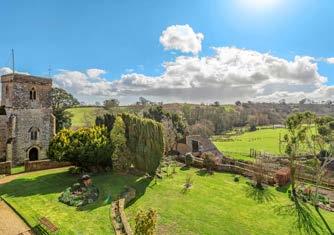
Located on the edge of the village with views over the surrounding countryside.

One of the biggest new homes in the area, successfully sold off market to a couple from Hong Kong.
A beautifully designed 4 bedroom home close to the vibrant Queen Mother Square.
 Hilfield Dorchester Enjoying an elevated position with panoramic views of unspoilt Dorset countryside
Hilfield Dorchester Enjoying an elevated position with panoramic views of unspoilt Dorset countryside
Established guest house and building plot with stunning views over the Golden Cap.





A substantial and impressive 5/6 bedroom family home on the water’s edge with fabulous panoramic harbour views

to the


Town centre commercial property investments have fallen victim to the perception that they are overcomplicated and risky. Not so.
The reality is that the majority continue to offer good returns on rents received, even if capital growth is often limited. More often than not, they are a good source of income with strong rental returns, but won’t necessarily offer brilliant growth in the capital value of the investment over time.
The industry is going through unprecedented change. Advancements in technology have accelerated the evolution of shopping habits and the way we work, which has had a major impact on long-established traditional occupiers in both the retail and office sectors.
Changes in our shopping habits have prompted the Royal Institution of Chartered Surveyors to issue guidance notes to all RICS-registered valuers in the commercial property sector, advising that due caution should be applied when providing clients with valuation advice on such properties.
Woolworths over a decade ago, with more than a few others sandwiched between the two.
This has had a knock-on effect on other sectors within the industry, with demand rising in the warehouse, storage and distribution property market where modern retailers seek comparatively cheap storage for goods which are then displayed on virtual shopfronts via the internet.
The result is an obvious and continuous increase in the departure of traditional town centre occupiers, which lazy commentators label the “death of the high street”. I would argue that the high street is far from finished. We are just at the start of a new phase in the transformation of the high street.
The commercial property industry faces challenges in coming years, but there are more opportunities arising for creative investors and developers. Enquiries from commercial occupiers offering fresh consumables such as cafés, or products that are impractical to ship or don’t lend themselves to internet sales, as well as those offering services such as hairdressing and beauty salons, are on the rise.

Permitted development allowing the conversion of upper floors from commercial space (generally offices) to residential accommodation provide further opportunities for value to be added to high street properties.


The industrial and warehouse sectors have seen a major increase in demand from both investors and occupiers, compressing yields. With values of town centre retail buildings falling in general, there are some lucrative openings for investors, provided they have good professional advice.
There is, therefore, merit in considering exploring town centre property investments, especially while most are looking the other way!
Put simply, the way most of us live, work and shop has changed dramatically over the past 20 years which has put companies who have not managed to evolve alongside our habits out of business. I could recite any number of examples, from the recent demise of Thomas Cook to the sad end of
The town centre commercial property market offers some lucrative openings for investors, says Ryan Holmes
They are a good source of income with strong rental returnsRyan

HMRC has sprung a few nasty surprises on buy-to-let investors over recent years: 3% stamp duty, and a curb in mortgage interest relief have impeded the opportunity to make a decent return. Add to this the recently introduced tenant fee ban which is deemed to favour tenants, and all of our sales offices report a reduction in the number of properties being bought by investment landlords.
Holiday lets are a different matter; letting a furnished property as a holiday let actually offers some significant tax advantages. Mortgage interest payments, council tax and utility bills can be off-set against income for tax purposes. This has seen a significant growth in holiday accommodation throughout our region, much of which is self-managed by owners using sites such as Airbnb and HomeAway.

Every year, many landlords of holiday accommodation invite us to discuss their options – particularly during the autumn at the end of a hectic summer season. Some are looking for tenants over the winter months, while others have become disillusioned and are considering longer-term lettings.
When you weigh up the balance of comparatively high weekly rents from holiday letting against the figures you might expect from longer-term letting, holiday letting looks attractive. However, they are hard work with change-overs often occurring more than once a
week. Add to that garden maintenance, high wear and tear, and upkeep of all furnishings. We are fortunate to live in a beautiful area of the country, popular with holidaymakers, and consequently there is plenty of short-term accommodation available. But outside the high season, supply of property can outstrip demand, resulting in prolonged empty periods when heating and running costs can mount up. Insurance companies often impose winter un-occupancy restrictions or additional requirements for visits.
Long-term letting, particularly when using a managing agent, gives a landlord assurance that all legislation and safety regulations will be taken care of. So, while there is a flux of holiday letting available, the current shortage of longer-term rental properties is driving rents up, and over the course of a year there is perhaps a smaller difference in net returns than you might expect.
Symonds and Sampson Lettings and Property Management manage more than 900 properties throughout the region. For a rent appraisal and landlord guidance, please contact your local office.
Karen Mitchell breaks down the pros and cons of each form of lettingKaren Mitchell MARLA Lettings Yeovil kmitchell@symondsandsampson.co.uk 01935 423526
A furnished property as a holiday let offers some significant tax advantages
Long-term letting, particularly when using a managing agent, gives a landlord assurance that all legislation will be taken care of
Adrienne Mathias has worked in our property management department for two years


6.00am:It’s an early start to get the horses done and the children off to school.
8.30am:I usually pop into our property management department in Poundbury. It’s a great time of day to catch up with my colleagues, before heading out to some of our 1,000 (just under) fully managed properties across Dorset, Devon, Somerset and Wiltshire.
The property management department is a very busy one. We all bring different skills and are a tight-knit team who work very closely together. I download the list of properties and note any issues which need particular attention. Having been with the company for two years, many of our tenants are familiar with me, and my Airedale terrier who often accompanies me to work. His favourite place to work is West Bay, as at lunchtime he gets a run on the beach.
works so I can report back to the landlord and demonstrate what has been done.
The tenant of this property owns a terrier herself, and has known mine since he was a puppy. Before we leave, the Airedale is treated to some rather splendid snacks from the local butcher.
This role provides the best work views on a daily basis! Dorset is a beautiful county

11.00am: The second visit of the day is a modern apartment in town. The tenant has recently called in to say the property is damp. Upon visiting the property, it is evident that the ‘damp’ is in fact condensation caused by poor ventilation. I discuss ways to manage and eliminate the problem with the tenant. This role often calls for a gentle and diplomatic approach, and we take pride in working in a courteous and constructive manner alongside our tenants and landlords to overcome any such issues.
12.30pm: I call into the local office to collect the keys for my afternoon visits. Working in all the areas I cover, I am lucky enough to know many of the Symonds & Sampson team. It’s always great to get the opportunity to touch base with my colleagues across the region.
9.30am:My first visit of the day is to a Grade II listed manor house. The grounds are extensive, and recent tree work has taken place. This visit definitely calls for wellies!
The property retains many original features, such as fireplaces, wood panelling and traditional plaster. Over time, cracks have appeared in some of the walls, which is inevitable. These are closely monitored and documented.
I notice a small water mark on the ceiling of the top floor, which could indicate an issue with the roof or guttering. I report this to the allocated property manager who instructs our local specialist contractor to investigate. I photograph the recent tree
4.00pm:When all the visits are complete, I return to the property management office to compile the reports. The reports are reviewed by the property managers who address any maintenance issues, before being sent to our landlords.
After a productive day at work, the Airedale and I head home. Once the horses, dogs and other family members are done, it’s time to relax!
Studio flat within a pretty Grade II Listed building, located in the popular market town of Blandford.

A country house of great style set amid beautiful countryside in a rural yet accessible location.

A charming two bedroom cottage, retaining several character features.
An immaculately presented 19th century farmhouse with beautiful large gardens, in a lovely rural setting.




A detached bungalow with breath taking views across the Jurassic Coast, situated in a quiet location.
Unique 4 bedroom barn conversion in the heart of the Tarrant Valley overlooking the surrounding farmland.

Discover what it takes to be a firstclass auctioneer, relive auction highlights from 2019, and find out why buyers are flocking to country house sales. We turn the spotlight on historic Parnham House, get creative with the Guggleton Farm Arts Project, and step into the ring at Frome Market. There’s also a chance to spot a familiar phizog among our ‘Farming Faces’, and rekindle fond memories from another busy year at our farm dispersal sales.
t Christmas Rose in Lustreware Jug by Vanessa Bowman, www.vanessabowman.co.uk
Lester Williams: “My father believed that a farm should be passed to the eldest son, so my brother took over our farm on the edge of Exmoor. I still wanted to be involved in agriculture and was passionate about going to market, so I asked our local firm of auctioneers if I could work at their market for free to gain experience. I was hooked.”
Lester Williams: “Knowing your buyers and sellers is vital. If you know that a particularly strong buyer is attending the auction in person or on the phone, you can have the confidence to encourage entries from the seller. It is a two-way game – you need the lots but you must also have buyers. Leaving matters to chance can be dangerous.”
Mark Lewis: “My father was an auctioneer and most holidays in my formative years were spent with him at market and on farms, so it was a natural career choice for me.”

Mark Lewis: “Standing hay, that had ‘gone over’, with just one farmer in attendance. It could have been a disaster but he helped me out by bidding on my first call.”
Mark Northcott: “A Friesian bull calf in 1974 at Sturminster market.”
Lester Williams: “Between school and Cirencester I worked for an estate agent in Minehead and they offered me the opportunity to help sell at a house clearance auction – the first lot I offered was a lawn mower.”
Charlie Coleman: “A pony at Beaulieu Road pony sales after the auctioneer at the time was taken ill. I remember the 600 guinea reserve! I had been waiting for a long time to have my first chance at selling and was due to begin with the vegetables and produce. To be thrown in like this will stick with me forever.”
Greg Ridout: “I’m a bit of a geek when it comes to machinery, so when we catalogue an auction I try to scribble down every bit of a machine’s specification. We also spend weeks on the phone to buyers before every auction to drum up bidders and ascertain values. We have one shot at doing our best for our clients and I want to be the best at what we do.”
Mark Northcott: “It has always been said that anyone can sell anything on a good trade but when the economic climate is tricky and bids are not forthcoming the skilful auctioneer will draw on their many years of experience.”
Mark Lewis: “You must really enjoy what you are doing and engage, while empathising, with both buyers and sellers, and read body language. People in the room will be nervous; if they are relaxed and enjoying the auction they will bid more freely. It is a delicate balance between being affable and entertaining but also in control of the room.”
It is a delicate balance between being affable and entertaining but also in control of the room
Five of our finest offer their insights into the ‘dark art’ of auctioneering
Greg Ridout:
“Confidence and a calm head, when you have to think on your feet, is paramount.”
Charlie Coleman: “By having the charisma to enjoy and embrace what you are selling, which leads to a good rapport with vendors and purchasers. It’s also vital to maintain respect and achieve the best possible outcome. Without the respect of both vendors and purchasers, the rostrum can be a very lonely place.”
Mark Lewis: “We had a herd of cows to auction near Dorchester but my father was taken ill on the day of the sale. My client, Suzy Vincent, said to me afterwards: “That was the day you changed from a boy into a man!”
Greg Ridout: “Auctioning a 1948 Series 2 Field Marshall tractor fitted with an aviation cab at West Stafford for £18,500.”
Lester Williams: “A Welsh sheepdog at the Bath & West Show.”
Mark Northcott: “Mumble, stutter and make it obvious when they are struggling. I have seen auctioneers shout and become aggressive, trying to intimidate the audience. It never works.”
Mark Lewis: “Make it very clear when they do not have the bid!”
Greg Ridout: “You need a rhythm and you need to stay calm. Rushing because of nerves ultimately makes you miss bids and knock items down too fast.”
Greg Ridout: “Each year a group of school and university friends go to Devon shooting, and every time I have to stand on the table after the evening meal and sell something while they all shout and heckle!”
Mark Lewis: “I give regular talks to all sorts of societies from the WI to Young Farmers and schools. The demonstration of selling at speed usually wakes up the audience.”


Lester Williams MRICS FAAV Partner Sherborne lwilliams@symondsandsampson.co.uk 01935 818513
Mark Northcott MRICS FAAV Partner Yeovil mnorthcott@symondsandsampson.co.uk 01935 382909
Greg Ridout MRICS Rural Partner Yeovil gridout@symondsandsampson.co.uk 01935 382909


Charlie Coleman FLAA Rural Auctioneer Yeovil ccoleman@symondsandsampson.co.uk 07494 588013
















result in all the
The
are highly delighted and extremely impressed with your calm efficiency. Well done you.”

From cottage renovations to commercial shops, agricultural land, development sites and the usual eclectic lots we travelled to four counties in 2019 sourcing the very best lots for you
Most legal downloads: 753 legal documents were downloaded by the bidders for Sycamore Drive, Yeovil which then sold for 61% above guide.
Highest price above guide: Penwithen Lodge, a detached lodge house, sold for 135% above guide!

Most bids: 64 for an individual village building plot in Marnhull, Dorset.
Most distant bidders: The Cayman Islands, 4,600 miles from Dorset, but they were unsuccessful!
Most historical: The Billet, Sutton Mandeville, Wiltshire. This was a World War I officers’ billet overlooking the badges carved into the hillside. It had fallen into disrepair but we received interest from as far afield as Canada.

Biggest surprise: The Boat Deck, Weymouth, Dorset where the buyer paid cash for the full sale price. The bank were not very pleased when we tried to pay in cash at 4.25pm on a Friday!
Highest attendance: Our sale in Wimborne in June attracted a crowd of about 500 people who saw a 100% clearance.
Best commercial lot: A commercial ground lease until 2034 with an income of £7,000 pa attracted interest from numerous London and regional investors. The sale price of £200,000 was 33% above guide.
Highest land price: £22,000 for 3.95 acres near Wincanton. The whole village seemed to be keen to buy. Highest woodland price: £14,300 for 2.2 acres of mixed deciduous indigenous trees near Sherborne, Dorset.
Best wreck: Corhampton Road, Bournemouth is a detached house with some internal cracks. Buyers were not deterred and after 84 viewings and 413 legal downloads the sale price was 37% above guide.

Best building plot: Near Blandford, Dorset where a site for two semi-detached houses sold, after 42 bids, for £420,000 – 97% above guide.
Best potential development site: Townsend Road, Seaton, Devon. A house for renovation and a large garden with development possibilities and views towards the sea. The sale price was £635,000.
Most unusual: Kinghay, East Knoyle, Wiltshire. A wooden bungalow set in grounds of about 0.67 acres. Described by one viewer as a piece of paradise, it sold to a buyer in Italy.
Most viewings: Churchfields, Salisbury, Wiltshire had a very short marketing period and we had 81 viewings in three weeks.
Best buy bidding blind: Market Place, Warminster, Wiltshire a commercial shop premises with two flats above returning an income 11%. The buyer from London checked Google street view and that was good enough to make him bid.
Most interesting: A pair of cottages near Taunton, Somerset requiring complete renovation with no internal viewings allowed.
Lowest price: A lock-up garage in Poole sold for £9,250
Auction entries welcomed – cottages and houses for improvement, building plots, agricultural land and commercial lots. Please contact Mark Lewis 01258 473766

Duke’s auctioneers has found that country house auctions are having a renaissance in Dorset and across the UK. At a time where provenance and originality are becoming more and more important, fresh market material from long untouched country houses is growing in value.


Some country houses can offer items that have been hidden in the house, unseen by the general public, for hundreds of years. Moreover, due to the distinguished nature of the owners of these properties, the items offered often have both long and important recorded histories.
The exceptional items from this sale also performed to a very high level; as well as interest from private buyers, the top traders of the country all competed and pushed the price of lots higher.
The outstanding lot from the sale, a fine George I burr walnut bureau bookcase in the manner of Peter Miller, was estimated at £40,000-60,000. Traders were drawn to the fact that this bookcase had been hidden in the house for so long, it therefore had the desired novelty and freshness that appeals to the market.
Traders were drawn to the fact that this bookcase had been hidden in the house for so long
Items to be sold at auction from a country house sale receive additional attention as they appeal to the antiques trade and invested locals. Duke’s recent experience selling the contents of Moigne Combe house demonstrated this; locals who had grown up near the property, or had even worked on the estate, came to view in high numbers.
This encouraged an overall increase in the values of the items sold, with interested parties wanting to acquire a memento from the house. This showed most obviously with the lower end and normally less valuable items to be sold.
For example, Duke’s sold a “Dumpy” doorstopper, originally valued between £50 and £100, for £190 including buyer’s premium. This is almost twice the top end of the estimate and more expensive than if you were to buy one new.
Also, it had a greatly significant provenance, it was perhaps the most important item in a collection that was passed down through generations of the renowned Bond family. The competing dealers bid until the price finally settled on a total of £120,000 including buyer’s premium.
This sale clearly exhibited how there is rising value placed on items with the allure of a country house provenance.
Duke’s auctioneers has also sold the contents of Athelhampton House, one of the most important Tudor manor houses in England. Embracing the resurgence of recent country house sales, the owners of Athelhampton elected to sell a large part of the interior through Duke’s. This decision is testament to the increasing reception of country house sales in the public eye and will have been influenced by notable results from previous sales.
At Duke’s auctioneers we believe the resurgence of country house sales is a wholly positive signal. We believe that there has become a wider appreciation for both locally and historically significant items. The market has proven that exciting fresh antiques are still appropriately, highly valued.
 Garry
Garry
Drawn by the allure of hidden treasures with impeccable provenance, buyers are flocking to country house sales, says Garry Batt
Parnham House is a 16th century Grade I listed house just outside Beaminster in Dorset. Historic England describes the house as “exceptionally important” but the auctioneers in 1896, when the property was sold on the open market for the first time, preferred “an ancient Elizabethan mansion” and “a well-known country seat in West Dorset”.
It certainly has quite a history. A house had been on the site since the 1400s and was owned by the Strode family until 1764.
History books report that the property was sold after the death of Sir Henry Oglander, but the trustees were selling under a trust contained in the will of the late Admiral Sir R.O.B. Fitzroy who had died in 1865.

He was an English officer of the Royal Navy and a scientist who captained HMS Beagle during Charles Darwin’s famous voyage.
He was a pioneering meteorologist who made accurate weather predictions which he called forecasts and he established what became the Met Office and created systems to get weather predictions to sailors and fishermen.
That is why Fitzroy is one of the points on the shipping forecast.
The sale particulars gave the purchaser the option to buy the contents at valuation, but they clearly did not want them, so they were put to auction.

HY Duke & Son held a three-day sale in December 1896 on site, referring to the “costly contents of this ancient mansion including the valuable old English furniture of the best manufacture in excellent condition”.
The sale included 38 best Persian, Turkey, Axminster and Brussels carpets; large silk damask and other window curtains; a semi-grand piano forte; stuffed birds; cut-glass chandeliers; 12 complete bedroom suites, and kitchen and other culinary requisites.


There was also a manual fire engine and 36 leather buckets which, considering the recent events, is quite poignant.
The library, silver and paintings were taken to London for sale by Christie, Manson and Woods. Highlights included books on natural history voyages, together with French and Italian literature.
The paintings listed included Annibale Carracci (the virgin and child with cherubs), a Poussin (a landscape with buildings and figures), and a Van Dyck (a youth in red dress – oval). It is amusing to see this almost lazy description of paintings that could be priceless today.
There was also the Strode gold signet ring engraved with the Strode coat of arms which had been lost for many years but was found when excavating Beaminster tunnel!
Parnham was bought by Vincent Robinson who erected the market cross in the town in memory of his sister.
When Parnham House was sold in 1896, it was among the finest homes in Britain. Caroline Childs-Chaffey looks back Caroline Childs-Chaffey Residential Beaminster ccchaffey@symondsandsampson.co.uk 01308 863100It is amusing to see this almost lazy description of paintings that could be priceless today
We turn the spotlight on Guggleton Farm Arts Project in Stalbridge, Dorset, with its thriving programme of workshops, lectures and exhibitions

Guggleton was opened in December 1995 by Isabel de Pelet BEM, particularly known for her promotion of artists in Dorset, especially the young and up-and-coming. Guggleton’s principal gallery had been a carthorse stable and the smaller studios were lean-to calf stalls. While the buildings were converted, Isobel made sure that they, and the yard, were sympathetically modernised and still retained their recognisable features, so that locals could remember when and where the herd of cows came up Station Road for milking twice a day.
Guggleton was founded to allow newly graduated artists to have studio space for working, supported with guidance and help.
Isabel believes that “artists working alongside and within an active community create a positive way to enrich and stimulate all those who involve themselves”.
Guggleton has received interest from all over the UK and overseas. Isabel is on the Arts Committee of the Royal Bath and West Show – furthering her belief in linking artists to their community.


At the beginning of 2019 a search for a new studio led Deanne Tremlett to The Gugg. Since that time, Deanne has helped in the continuing development of Isabel’s vision, as it is one which entirely mirrors her own.
Deanne says, “At Guggleton we are about
creativity and development. We aim to provide a welcoming environment for the creation of the new, in whatever form that might take for the individual.
“We support established artists by providing them with a space to experiment; new artists with the network, structure and exposure to develop; and raw artists with the opportunity to grow.
“Exhibitions at the Guggleton vary from season to season with one core theme – growth. We are, after all, occupying a farmyard.
“We hope to be able to demolish the threshold/barrier issues that face many Fine Art institutions [those which make people feel like places are ‘not for them’] by remaining true to our community; while at the same time building on and growing the receptivity of the surrounding area to the arts.
“That said, we aim to offer support over every aspect of a person’s creative outpouring, with a programme of exhibitions, events, workshops and talks that develop both the exhibitor and the viewer; entertaining and stimulating while remaining playful and relevant.
“If our approach to life and the arts in any way coincides with your own, then there are many ways that you can become involved at the yard.”
Guggleton Farm, Station Road, Stalbridge, Dorset DT10
01963
Open Tuesday-Saturday 11am–3pm ann.guggleton@gmail.com
We aim to provide a welcoming environment for the creation of the new



TB Orange Market 10:30am (Monthly)
Calves 10:00 am Pigs 10:15 am (Fortnightly) Sheep 10:30 am Dairy Cattle 11:00 am Weaned Calves 11:30 am (Fortnightly) (following the sale of calves) Prime Cattle/Cull Cows 11:30 am








Friday Store Cattle 10:30 am Store Sheep 10:00 am (Monthly)















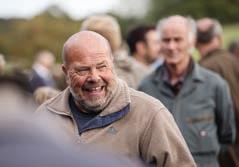
























Tractor: £77,500 – 2018 Case Optum 270 CVX sold to a farmer 120 miles away.
Telehandler: £36,300 – 2018 Massey Ferguson TH7038 with 1,630 hours.
Combine harvester: £49,000 – 2012 Massey Ferguson 7370 Beta.
Sprayer: £69,000 – 2012 Bateman RB35.
Vintage tractor: £17,000 – 1975 Massey Ferguson 1200 with 6,500 hours.
Biggest sale turnover: Cowdray Home Farms in Sussex.
Biggest sale number of lots: Green Services, Piddletrenthide – 503 lots
Total number of lots in 2019: 10,450 –that’s a 20% increase on 2018.
Most difficult lot to sell? All we can say is that the colour is crucial.
Most discussed lot: Bateman RB35 sprayer – we ran a social media
campaign challenging people to guess the price. Three people were within £500 of the £69,500 sale price.
Furthest buyer: Inverness (626 miles) or Cookstown Northern Ireland (11 hours if you catch the traffic at the wrong time).
Wettest sale: The Axminster collective sale was a torrential day which made writing sale prices down on the sale sheets a challenge.
Hottest day: Holloway Farm at Shillingstone; sun screen, hats and icecreams were the order of the day.
Amount of grass and maize silage sold: 3,320 tons
Acres of straw sold: 10,375. The number of bales sold: Silage 6,333. Hay 5,371, Straw 13,896.
Total: 25,600
Most surprising price: Ferguson halftracks selling at £2,500 for Colin Foot. He told us they were valuable!

Where did our buyers come from? 24 counties plus Ireland, Scotland, Jersey, Isle of Wight and the Isle of Man.



Largest crowds: For Stuart Buckland at Blandford, and Martin Brown at Maiden Bradley, Wiltshire. Family, friends and farmers came in their droves.



Charities supported:
Future Roots with a donation of £3,418.60
The Sarah Burkeman Memorial Fund for the Royal Marsden Cancer Charity

with a donation of £4,400 for the sale of the John Deere 2650 on behalf of the executors of Mrs Fiona Burkeman.
Best thank-you: “Thank you for making the sale so memorable. The outcomes were completely beyond our expectations … you gave us all confidence and encouragement as well as lightening the load with humour. You have all made a lifechanging day an enjoyable and rewarding experience.” Martin and Rosie Brown

Our must-read assessment of the farmland market, highlights from favourite farm sales, details of the new Environmental Land Management Scheme, and how ‘farm to fork’ is championing local produce. We look at insect-friendly farming and the unusual names our farmers give their fields – Soggy Bottom, anyone? There’s time to raise a glass to the region’s wine producers, before taking a whistlestop tour of Dorset film locations. We offer advice on the value of an agricultural tenancy when a partnership breaks down, and introduce you to the next generation.
t Lady with a Basket by Kim Creswell, www.kimcreswell.co.ukAs market leaders in our region, we have our finger on the farmland pulse. Andrew Tuffin, Head of Farm Agency, provides an insight into factors affecting the current market
If you are reading this, you probably own land or wish to buy land and are interested in the current – and future – state of the farmland market. The headlines are: falling supply, variable demand and diverging values.
Less than 100,000 acres was advertised for sale in Farmers Weekly during 2019, a year-on-year decline of 40%. This is the lowest amount since 2004, the year before single farm payment was introduced.
Political uncertainty and the expected but largely undetermined change to support payments is delaying decisions to market land more than it is affecting values.
The main reason for sale continues to be retirement, followed by change in ownership policy and death. Forced sales through debt are present but relatively low in number.
Commercial farmers now only account for approximately 50% of land buyers, whereas historically this has been around 60%. Weaker cereal and beef prices have not helped confidence but the largest deterrent is uncertainty about the future of subsidies and trade deals. I dare say I will be reporting the same in 12 months.
Corporate and individual investors are becoming more prominent. Attracted by long-term capital growth and less volatility than other types of property and the stock market, many view farmland as a safer asset.
Falling supply, variable demand and diverging values.
The slight cooling of bare land values since their 2015 peak has created an opportunity for investors to make a reasonable return. This potentially opens doors to farmers to rent, contract farm or take grass keep to provide the landowner with a return on capital or to keep the land tidy.
Residential and lifestyle buyers can have a huge influence on value. With many still earning good bonuses, land and even whole farms in the right locations, often adjoining existing property or near good private schools, can achieve a substantial premium.
On a national scale tax breaks, low interest rates, rollover money and healthy investor interest continue to provide the fundamental demand for farmland. Combine this with low supply and the market has been more robust than many predicted.
On a global scale the increasing population is driving the requirement for food and energy production, often conflicting with environmental sustainability. These are competing uses of both productive land and marginal land which is becoming more relevant as technology advances.
Britain is better placed than many drier areas of the world to continue with food and energy production in the long term. Our established property laws, transport network and weaker pound will make UK farmland an attractive longterm proposition for investors and international buyers.
Quality is sometimes less of a factor in these circumstances. For instance land with a view is, by its nature, often sloping pasture. In the right area it can achieve as much as arable land; in the wrong area, not even farmers want it.
Following an often lengthy planning process, proceeds from development land sales are filtering through to farmers and landowners who are seeking to rollover gains.
Investors and rollover buyers tend to seek larger parcels of arable land with a minimum of 200 acres and preferably over 500 acres. Such parcels tend to create the most interest, therefore it is important to market widely
Conservation-minded buyers – usually individuals or charity/ trust funds – sometimes express interest in marginal land, but the land often requires specific attributes such as woodland, water or accessibility, to be of value to them.

Most farmland is achieving between £7,500 and £9,000 per acre excluding small blocks under 10 acres, and woodland. However, the range of values is extremely wide, achieving from £6,000 per acre to £15,000 per acre.

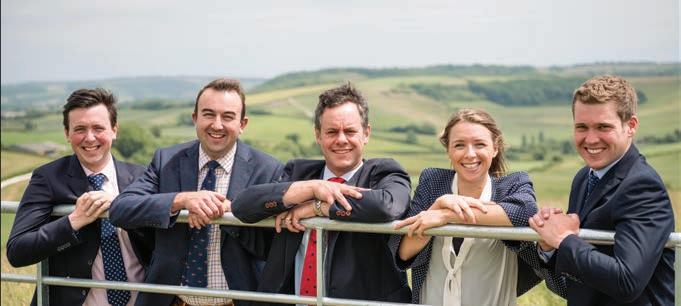
Nationally, average values are a fraction down year-on-year and around 15% below the peak in 2015. However, values are 40% higher than 10 years ago and 250% higher than 20 years ago.
Regionally, we have not experienced quite the same fall since the 2015 peak. Demand for smaller parcels of land can be fierce with some exceptional prices being achieved.
Farms often have surplus farm buildings and we work closely with our planning and development colleagues to achieve Class Q consents and disposals. A premium is often achieved by attaching land to a plot, and we are always pleased to advise.
Continuing uncertainty over Government policy and support, together with healthy rents being received by retired farmers, will continue to restrict supply in 2020 resulting in fewer transactions.

However, hopefully as trade deals are agreed, supply will start to improve in the medium term.

The range of values will continue to increase, although still hover around the £8,000-£9,000 per acre average.

As a Partner in the firm and our Head of Farm Agency, Andrew Tuffin is an unrivalled expert in the business of buying and selling farms. Here he picks his highlights from Symonds & Sampson’s 2019 sales

483-acre arable farm with 3 dwellings and traditional farm buildings. Guide £5.3m. 20 viewings by investors and farmers, national and local. 7 offers. Sold above guide.




422-acre farm with 3 dwellings, pasture and a shooting range. Sale agreed, fell through, repackaged, remarketed and sold in excess of original guide price.
Lower Bowridge Hill Farm, Gillingham 109-acre grassland farm for improvement. We had sold the deceased’s dairy herd in 1999. 46 viewings and sold as a whole to a farmer.
Park Farm, Charminster 99-acre residential and equestrian holding. Under offer for a figure in excess of guide after just 2 weeks and completed within 3 months from instruction.

90-acre livestock farm with attractive ag-tied bungalow and good range of farm buildings. Sold after 13 months of marketing.
44-acre residential farm with an immaculate Grade II* country house set in enchanting gardens with a lake. Agreed in 2 weeks, over guide after stiff competition.


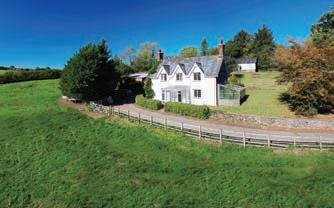
100 acre pasture farm and barns with consent to convert to 2 detached contemporary dwellings. Offered in 10 lots and sold to 7 different buyers.
Class Q barn in 4 acres. Sold at auction to neighbouring farmer. Sold on barn with 1 acre to an underbidder, with the farmer keeping three acres.

69 acres of pasture land offered by auction in 8 lots. Purchased by 6 different buyers in total, each lot well over guide and averaging £11,000 per acre.

101 acre residential farm offered in 3 lots and sold as a whole. Worked in conjunction with Paul Heard Rural Professional Services, Wellington.
It’s a sad fact that many consumers have lost sight of where their food comes from and how it is produced – choosing highly processed, over packaged, branded produce over locally sourced goods. Where food was once a huge part of communities, it is often now just a sideshow.
In a bid to fight back, the ‘farm-to fork’ movement created a concept that has become one of the fastest growing trends in the nutrition world.
NFU President, Minette Batters says: “Safe, traceable, affordable food that is produced to high standards of animal welfare and environmental protection is a right for all, and British farmers should be the number one supplier.”
The concept of ‘food miles’ has been widely investigated. Data produced from the National Food Agency reveals that 34% of shoppers give reducing food miles as the main reason to buy local food. It is obvious that local food means lower transport costs, less pollution and freshness of produce.

Much of the local produce you’ll find at farmers’ markets and farm shops has been picked within the previous 24 hours
The food miles concept helps shoppers change their habits in an intuitive way and should be utilised to convey the wider environmental benefits of local food.

Amid the current uncertainties surrounding the future of British agriculture, an increasing number of farmers are diversifying away from their core farming enterprises in a bid to safeguard the long-term sustainability of their business and gain a reliable source of income.

Supermarket produce is often grown and processed with shelf-life top of mind. These products may have been transported over long distances and will often have been sitting in distribution centres before arriving at the store and eventually making it on to the shelves.
In contrast, much of the local produce you’ll find at farmers’ markets and farm shops has been picked within the previous 24 hours. In addition to the advantage in freshness, growers who cater to local customers aren’t constrained by harvesting, packing, transport and shelf-life quality issues. Instead, they have the freedom to select, grow and harvest their produce to ensure the highest qualities of freshness, nutrition and taste.
Farmers’ markets and farm shops are an excellent way to source local produce. Most rural towns have one, and they’re popping up in big cities too. According to the National Farmers’ Retail and Markets Association (FARMA), there are over 4,000 farm shops and over 500 farmers’ markets in the UK.
With the 21st century providing hectic schedules, we can easily be forgiven for a mad ‘one dash does it all’ to our nearest supermarket. So, while ‘local’ is no longer our only option, and sometimes convenience is paramount, we can choose to reap the benefits of going back to our roots.
Buying local foods is not only sustainable but supports local food producers and ensures more money stays in the local economy and goes to those who work hard to ensure that food goes from the farm to our fork.
Zoe Brain BSc HonsFrom bustling markets to farm shops, there’s a host of tempting alternatives to the identikit supermarket chains. Zoe Brain encourages us to take our pick of locally grown produce
The Common Agricultural Programme will soon be replaced by The Future Farming and Countryside Programme. Developed by DEFRA, the new services and interventions are being designed to support farmers and land managers.
Under the programme, current land-based payments to farmers will be phased out over a seven-year period, starting in 2021, and succeeded by a new Environmental Land Management Scheme (ELMS). The scheme is planned as part of a system paying ‘public money for public goods’.

Under the new system, farmers and land managers can enter into a contractual agreement with the Government to produce environmental land management plans providing outcomes, for which they will be paid.
However, DEFRA has not yet determined the level of payments which will be made under the new scheme.


The scheme will be delivered through farmers and land managers on a 25-year environmental plan which aims to support the following:
• Clean air and clean and plentiful water.
• Thriving plants and wildlife.
• Reduction in and protection from environmental hazards.
• Adaptation to and mitigation of climate change.
• Beauty, heritage and engagement with the environment.

A new relationship with land managers will be formed through a contract to deliver public goods, alongside market productions, rather than a direct subsidy.
The idea behind the scheme is to trigger ambition through providing land managers with choice and control. Prescribed directions on how to achieve outcomes will not be provided – the farmer or land manager will focus on how to achieve the outcome and improve quality with guidance from an expert adviser.
The onus is on the farmer and land manager to demonstrate compliance. The concept is payment for outcomes: ‘the more you do, the more you get paid’.
DEFRA is currently developing a design for the new ELM scheme and is testing new ideas. The developing and testing phase is likely to continue until 2021.
Once developed and tested, the new scheme will be implemented on a large-scale national pilot from 2021 until 2024. From 2025, the ELM scheme should be in full operation.
Lucy Carnell MRICS Rural Surveyor YeovilThe concept is payment for outcomes:
‘the more you do, the more you get paid’
Remember how insects used to accumulate on car windscreens? You may not see so many nowadays as they are in decline. Studies have shown this to be a problem across many parts of Europe. The economic value of pollination to crop production in the UK is estimated to be approximately half a billion pounds a year.
To address the declining situation, the Government produced a National Pollinator Strategy in 2014. A key part of the strategy asks that farmers and landowners incorporate a range of beneficial management practices on their farms to improve the provision of food and habitat for insects.
Mechanisms to improve pollinator habitat are available within the existing Countryside Stewardship schemes. The range of options, available under both higher and mid-tier will help create new habitats within the farmed landscape for pollinators and form a central element of the wildlife packages on offer.

For the arable or mixed farmer, two of the more focused options are AB1 nectar flower mix (£511/ha), and AB8 flower rich margins and plots (£539/ha).

The main difference is that the AB1 plots use a narrow range of legumes to create a huge amount of pollen and nectar in

the summer months with a shorter expected plot life, while the broader mix of species in AB8 such as knapweed, birds-foot trefoil, yarrow wild carrot and fine grasses will provide a longer lasting mixture that produces flowers for an extended period that appeals to a wider range of insects and is more persistent.
The options are not exclusive to arable farmers. Grassland farmers can also do their bit with the GS4 herb and legume rich sward option offering a payment of £309/ha. With a good mixture containing deep-rooted plants such as sanfoin, lucerne or plantain, the sward has good drought resistance and remains productive for both grazing stock and insects.
With a bit of thought about location, the options can be used to connect known hot spots of insect activity or to provide stepping stones so that a butterfly like the Small Skipper that does not like to venture far from food sources can move across the landscape.
Scientific work has shown that, to make a landscape pollinator friendly, there must be a number of 0.25 ha plots scattered around 500m apart.
Establishment is key with the plots. Prepare a good fine seedbed and broadcast the seed on to the surface, and lightly roll to enhance seed and soil contact.
A good time to do the work is late summer when the soils are warm and soil moisture levels are increasing. Frequent topping in the first year is vital to aid establishment.
Adopt a cutting regime that will enable a proportion of the plot to flower later in the season to give the insects as long a feeding season as possible and for those that hibernate, such as the Brimstone, a vital late season feed.
The National Pollinator Strategy aims to provide insects with food and a home. Harold Makant of Natural England explains how landowners can benefit from doing their bit
Harold Makant Natural England Harold.makant@naturalengland.org.uk
A good time to do the work is late summer when the soils are warm
If, like me, you grew up on a farm, you’ll be familiar with names such as Home Field, Eight Acres (or equivalent number), Cow Field, Orchard, Bottom Field, Top Field and The Meadow.
But what about the more unusual names? Borrow Bread, Dear Bought, Purgatory, Gaudy Close and Ding Dong are some examples that Farmers Weekly highlighted from A New Dictionary of English Field Names by Dr Paul Cavil (The English Place-Name Society, £22) – a new book on field name origins. Contributors also came up with a few interesting examples:
“My wettest horror field is perfectly named – it’s the Black Bog!”
“We have a First Humpy and a Second Humpy; so named as they’re both humpy and one is in front of the other.”
“Warren Field, Hump Back Field, Junk Field (used to be full of old scrap), and my personal favourite The Big Square Field.”
“Soggy Bottom. I am sure Mary Berry would have approved.”
“There was Slates on a Cotswold farm I worked on. The Cotswold brash was so thick it was hard to spot the soil but it still grew a good crop. Here in flat Suffolk we have Hillies near us – the only gentle slope for miles.”
“10 Acre … but the field is actually only five acres.”
“Starveacre and Worlds End are probably the most amusing I’ve come across.”
“Mud Pightle, Shepherds Hills and Bulfers.”
“We have one called Cheesecake. I don’t know why.”
As you can see from the above, field names may have derived from just about anything. The majority of names, however, would have come from Anglo-Saxon origins and passed down the generations.
Many would never have been written down, although old tithe maps and tenancy agreements would have been two sources of evidence of any historical data.

The old OS plans usually had a three-digit number relating to the parish in which it was located, and the more recent national grid series of plans have given each field a four-digit number based on its grid reference. Neither of these series of plans did

anything to preserve the individuality or historic context of old field names.
As a chartered surveyor, I have always taken time to write down information on field names where possible. I can’t imagine my father saying to me as a young man, “Go down to OS 319 and spread the manure.” Much more evocatively he would have said, “Go ‘n’ spread the muck on Sourdown.” I would have known exactly what to do!
What we have with field names is part of the rich tapestry of the English language. It is ever-changing, largely undocumented and capable of being lost forever, unless we write it down and make use of it.
I suggest that all landowners and farmers take a few minutes to write all they know about the names of their fields, and preserve this declining fragment of our past – before it disappears altogether.
 Philip
Philip
day
meadows’ monikers
What we have with field names is part of the rich tapestry of the English languageField names from Buckland Newton
The last 20 years or so has seen a surge of interest in UK winemaking particularly, though by no means exclusively, in southern England, as an accidental by-product of climate change.

Rising temperatures now mean that growing conditions are close to those found in the Champagne region of France. Marry that with sheltered, free-draining, south-facing slopes and the underlying conditions become ideal for wine production, in particular sparkling wine.
A small but increasing number of landowners are seeing the establishment of vineyards and winemaking as a diversification opportunity with many spin-offs, including tasting tours, corporate events, farm tourism and visitor-related activities.
Wine production itself can be a very volatile experience with wide variations in annual grape yields according to weather conditions. While 2018 was a bumper year for growers, it followed several much more variable years including a complete washout in 2012.
Added to this uncertainty, in the early years there is a period of significant capital expenditure for little or no return from the growing crop. The economics can look daunting with the establishment of infrastructure and planting of vines costing from £10,000 to £12,000 per acre, and annual maintenance costs of between £3,000 to £4,500 per acre.
Many owners of larger vineyards have taken the step of investing in their own winery, employing winemaking experts and producing their own-brand wine.

Other smaller producers may grow on contract and receive around £1,500 to £2,500 per tonne delivered, or they may send their grapes to a


larger winery for processing into their own-brand wine which they receive back for onward sale after paying a processing and storage charge.
My work with vineyards has encompassed valuation and tax arrangements, tenancy work and planning, while across the firm we have dealt with a number of sales, usually as part of larger, mixed use businesses and often including a residential element. Establishment costs added to underlying agricultural land value are unlikely to be returned in enhanced capital value at present.
In the following pages we look at three established and successful vineyards in Dorset and East Devon: Langham Wine Estate near Milborne St Andrew, Bride Valley Vineyard at Litton Cheney, and Castlewood Vineyard near Axminster. Each produces its own high-quality own-brand range of still and sparkling wines. Visit their websites to find out more.
Dorset and East Devon has become prime wine-growing territory. Patrick Woodford toasts the success of three top producersPatrick Woodford MRICS FAAV Partner Dorchester pwoodford@symondsandsampson.co.uk 01305 236573
What started as a childhood fascination with hedgerow fruits has seen Rob Corbett make the bold move to establishing a vineyard and making wine on his family’s 200-acre dairy and arable unit near Axminster in Devon.

In the mid-1990s, a block of steep land not suited to growing cereal crops or silage was planted with vines. “The hillside is south-facing – essential in the northern hemisphere if the vines are to get enough sunshine. This area is comparable to France’s Loire Valley and we have our own little micro-climate,” says Rob. “It’s mild here and we’re just 2.5 miles away from Lyme Bay.”
Rob makes both sparkling and still white wine, growing Pinot Noir, Chardonnay, Pinot Meunier and Bacchus grape varieties to create the desired results.

Planting to first harvest was a four-year wait. The first commercial vintage was in 2010 and this lay in the cellar for two years. So, in 2012, he had his first 1,000 Castlewood bottles to sell.
Managing vines and making wine while running the core dairy business makes certain times of the year extremely busy. Installing two robotic milking systems has, however, provided flexibility for Rob to pursue his winemaking passion. Pruning and trellising starts in December and goes through until March. Rob tends to all 5,000 vines himself.
Grape harvest is typically from late September onwards; then winemaking begins. The wines are fermented in both stainless steel and three-year-old Burgundy barrels before being bottled and allowed to mature for two years in Castlewood’s old stone barns.
Instead of choosing to supply local farm shops and restaurants, Rob invited everyone into his vineyard for the inaugural Castlewood Wine Festival, and sold his entire vintage in one day!
Back then he knew 80% of his customers, but business has grown to the point where he now knows only 20% directly. And the annual one-day ticketed wine festival continues. Five hundred tickets go on sale on 1 March and quickly sell out.
Rob now produces more than 8,000 bottles of Castlewood wine each year –selling at the festival, to private customers, and through a few select restaurants.
“We use the passage of time to clarify the wine – not chemicals or filtration. It’s important that we maintain the integrity of our product,” says Rob.
His next plan is to produce a semi-soft lactic cheese from the herd’s milk to pair with the wines. Rob says: “We’re still developing a recipe and involving all the chefs who buy our wines in the development process. It’s a really fun journey and we’re only just at the beginning!”
For further information and sales, visit www.castlewoodvineyard.co.uk or call 01297 552068.

Each year, the harvest from Castlewood’s boutique vineyard is enjoyed at the summer wine festival


At the heart of the Langham Estate sits the magnificent Bingham’s Melcombe Manor House, a Grade I listed house that has changed little since the reign of Edward VI. Acquired by John Langham in 1980, Bingham’s Melcombe is now the heart of Langham Agricultural Enterprise, today extending to over 2,500 acres.
The Langham Vineyard was established by John Langham on a very small scale but, in 2009, John’s son, Justin Langham, decided to develop his father’s project into a commercial venture and planted 30 acres of land at their Crawthorne Farm site near Milborne St Andrew.
With a south-facing aspect, chalk soils and a unique micro-climate, Crawthorne provides the perfect terroir for ripening the classic Champagne grape triumvirate of Chardonnay, Pinot Noir and Pinot Meunier.
canopy and promoting biological control organisms, the effects of disease are kept to a minimum. Grapes are handpicked and rigorous vineyard selection ensures that only the highest quality grapes arrive at the winery.
Housed in a characterful old barn, the winery provides a fusion of the old and the new. With a selection of temperature-controlled stainless steel tanks, as well as used French barriques, Langham Wine has all the tools required to produce exceptional wines.

With the winery located a short distance from the vineyard, the grapes are picked and processed within a few hours, avoiding the need for transport and risk to the grapes in transit.
Well-established hedgerows provide natural wind breaks and habitat for a large variety of beneficial species. The ability to grow their own grapes means that picking can take place at optimum ripeness without restriction of contract purchasing and this results in a better quality wine.
As an adjunct to the commercial farming operations, Langham Wine employs five staff holding roles in vineyard management, winemaking, sales and hospitality, as well as many seasonal staff during the picking season.
Organised tastings in the wine tasting room, catering and events at the Vineyard Café, vineyard tours and other activities supplement the core purpose of successful wine production.
Wines produced include classic Cuvée non-vintage, Blanc de Blancs Reserve, Rosé NV, Blanc de Noirs 2013, and Blanc de Blancs 2011. Wines produced on the estate have won many awards including, most recently, Supreme Champion at the Wine GB annual competition.
As a policy, the vineyard is working towards reducing chemical intervention. This is being achieved through diligent canopy management. By increasing the airflow through the
For further information and sales, visit www.langhamwine.co.uk or call 01258 839095.
Steven Spurrier is one of the most influential and celebrated individuals in the wine trade. In 2009 he and his wife

Bella established Bride Valley Vineyard on the stunning West Dorset coast between Bridport and Dorchester. The vineyard now produces a number of award-winning wines under the Bride Valley label and offers regular tours and tastings for visitors from around the world.

Steven and Bella made Litton Cheney their home in 1987 and Steven was keenly aware of the potential for growing vines on his wife’s 200-acre farm on the edge of the village. The clean, chalky soil was almost identical to that found in the Champagne region of France and the fine south-facing slopes offered a favourable climate for the cultivation of Chardonnay, Pinot Noir and Pinot Meunier vines – classic Champagne grape varieties.
Having spent a lifetime in the trade, the opportunity to produce his own wine was too much for Steven to resist. So 44,000 vines from Pépinières
Guillaume –considered the world’s best vine nursery – in north Burgundy were matched to the climate and subsoil, and planted over 25 prime acres on Bella’s farm.
The first harvest was gathered in 2011 and the grapes taken to Ian Edwards (2012 English Winemaker of the Year) at nearby

Furleigh Estate. Three elegantly sparkling wines produced in the traditional Champagne method were released in 2014 – a classic, clean Blanc de Blanc, a Brut Reserve and a rosé for summer drinking named Rosé Bella in honour of his wife.
After this promising start Bride Valley Vineyard struggled for a number of years with smaller-thanhoped-for crops but the wonderful summer of 2018 renewed everyone’s faith in the productivity of the Dorset countryside. Almost 60,000 bottles were produced, and Bride Valley Wines made its first still varieties – Dorset Chardonnay and Dorset Pinot Noir released in 2019.
In 2018, Bride Valley Vineyard also produced the UK’s first ever Crémant, which immediately scooped an SWA silver award. The Dorset Crémant is deliciously creamy on the pallet due to its slightly lower fizz compared to traditional sparkling wines. The 2019 harvest, despite the cold and the rain, did not disappoint and the future and continued quality of Bride Valley Wines, and indeed English wines in general, appears to be rosy.
Wine tourism is also on the increase and to accommodate growing numbers of visitors Bride Valley Vineyard has recently invested in a dedicated art and tasting room, with Steven’s cornucopia of pictures, artefacts and awards on display.
From this setting – a charming stable block opening on to the back garden of Steven and Bella’s home in Litton Cheney – the Bride Valley team host regular events. Guests can tour the vines, spend pleasant moments enjoying the beautiful Dorset views with glass in hand and take home some bottles of fine English wine at cellar door prices.
For further information and sales, visit www.bridevalleyvineyard.com or call 01308 482767.


The owner of Bride Valley Vineyard in West Dorset has years of experience in the wine trade
The opportunity to produce his own wine was too much for Steven to resist
Thomas Hardy classics, Oscar-winning blockbusters, and TV mini-series: our beautiful county has played a starring role on screen. Andrew Carless is ready for his close-up

Some of the most beautiful countryside in Britain can be found in Dorset. Whether you like dramatic coastlines, sweeping countryside or pretty cottages, the county has the lot.
Little wonder, then, that film directors have been drawn to Dorset when they have needed a brilliant location for a film.
We would expect films based on Thomas Hardy’s novels to be filmed in Dorset. It would be sacrilege to go anywhere else and the county has been the back drop to Far from the Madding Crowd twice, The Mayor of Casterbridge and, of course, Tess of the d’Urbervilles. Was there ever such a vulnerable heroine as Nastassja Kinski?

And in a reworking of a Hardy novel, Stephen Frears, himself a former Dorset resident, directed Tamara Drewe with Bond-girl Gemma Arterton taking on the role of journalist Tamara based on the comic strip by Posy Simmonds.
Sherborne School has also been popular, with films such as The Imitation Game, The Browning Version and Goodbye, Mr Chips, and the mini-series Wolf Hall all shot in and around the quad.
Milton Abbey School was used for television’s To Serve Them All My Days and the brilliant Ripping Yarns
Iconic film stills have been shot in the county; The French Lieutenant’s Woman was filmed in Lyme Regis and famously uses The Cobb as a dramatic backdrop, with a hooded Meryl Steep looking out to sea.

The town was also used for the 1995 and 2007 adaptations of Jane Austen’s Persuasion, whilst Emma was filmed in Evershot and Dorchester.
The coast has been used in other films; Portland Harbour took centre stage in the 2008 film The Boat that Rocked starring Rhys Ifans, Bill Nighy and Nick Frost about a pirate radio station in the North Sea.
Most recently, of course, West Bay has featured on the small screen in the multi award-winning Broadchurch, while the illfated Harbour Lights is thankfully a distant memory.
Nanny McPhee was partly filmed in the Purbecks, as well as Mansfield Park and the darkly comic Mike Leigh film Nuts in May. In 1997, Stephen Fry portrayed Oscar Wilde in the film Wilde; scenes were shot around Swanage Pier, Lulworth and Studland beaches.
The Blackmore Vale was the back drop to Fair Stood the Wind for France, and the famous chandelier scene in Only Fools and Horses was set up at Clayesmore school in Iwerne Minster.
So, the next time you walk into a pub and think someone is the spitting image of a famous actor, you may be right. You may even be asked to be an extra. You will, however, never outshine the Dorset countryside.
 Andrew Carless Partner Accounts acarless@symondsandsampson.co.uk
Andrew Carless Partner Accounts acarless@symondsandsampson.co.uk
The famous chandelier scene in Only Fools and Horses was set up at Clayesmore school in Iwerne Minster©1967 METRO-GOLDWYN-MAYER ©BBC
Anyone setting up a family farming business does so in the belief there will never be any disputes, but sadly that is not always the case. When families fall out, the impact can be dramatic for all concerned.
I was involved in a complex arbitration to consider the value of an agricultural tenancy following the unfortunate break up of a family farming partnership.

There was a significant amount of legal input, especially to establish whether the tenancy was held as an asset of the partnership. It was, so the benefit of the tenancy had to be valued which became a significant threat to the ongoing farming business.
Therefore, I would recommend that you think carefully before making the tenancy an asset of the partnership because, if the tenancy has to be valued, it could put a significant strain on the ongoing partners when having to pay an outgoing partner

The farm in question was on an estate where it was agreed that the landlord would not make a payment for the tenancy. So we had to work out the benefit to the ongoing partners of having a tenancy under the Agricultural Holdings Act., and thus a lower rent than an FBT.
tenancy based upon the profit rent, which is the difference between the open market rent and the rent paid under an Agricultural Holdings Act Tenancy. This can be a considerable amount.
I approached my valuation on behalf of the ongoing partners in two ways. First, I looked at the market rent, taking into account all the factors of the particular farm.
Second, I looked at the sustainability argument which is what the farm was producing by way of profits and, having allowed a reasonable return to the partners, what it could afford to pay in terms of rent. My valuation, which was a balance of my two methods, led me to value the tenancy at about £400 per acre.

The valuer for the outgoing partner based his value on a large profit rent, so that his valuation came to just under £2,000 per acre. We were some way apart and on 600 acres that meant there was a lot at stake, the Valuers were about £750,000 apart!
The arbitrator was a well-respected QC. He was an expert on the law, but his understanding of farming businesses and valuation were secondary to his legal expertise. He dismissed my sustainability approach, but accepted my analysis of the rent and based his award on a rent that was in line with my proposal.
The arbitrator came to a fair result which was much closer to my valuation but the stress and threat to the ongoing business was significant. .
When setting up your family partnership it is essential to take professional advice. Speak to your solicitor and accountant, but also make sure that you speak to your valuer to gain a true understanding any future claims.
Philip Pollard FRICS FAAV
I would recommend that you think carefully before making the tenancy an asset of the partnership
What is the value of an agricultural tenancy when a partnership falls out? Philip Pollard explains
Akey selling point for AMC has always been its light touch ‘lend and leave’ approach coupled with its ability to lend over a longer term. AMC supports UK farming businesses by lending them funds over 5 to 30 years for any business purpose. Lending is split between land purchases, capital investment, restructuring bank overdraft or term debt and working capital.

Restructuring debt and spreading loan repayments over a longer period or switching borrowing onto an interest only basis are all ways that AMC may help to save costs. AMC is able to offer long term interest-only loans and applications for this facility are increasing from farmer’s whose banks are unable or unwilling to offer such facilities.
Whether to take out long term fixed rate loans or to stay
with a variable rate loan is always a difficult decision to make, especially where we have been at such a low base rate for so many years. Fixed rate money is currently very affordable with the cost of funds still below the 1% mark at the time of writing. Many over the last year have opted for fixing but what is right for one may not be for another and each case is different.
With signs of more land coming on the market in 2020 AMC don’t just lend to traditional farmers but also provide Rural Business Loans to non-farming clients providing they are able to offer agricultural security and service the debt.
The Symonds & Sampson LLP team of AMC agents includes Edward Dyke, A-J Monro and Greg Ridout all of whom will be pleased to answer any questions you may have.
The Agricultural Mortgage Corporation (AMC) is a specialist provider of medium/long term finance for farmers and landowners.
Guaranteed working capital would help our plans








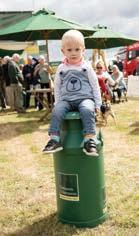











A look back at a fabulous year for our charity fundraising, all the fun of the rural shows, and interviews with the show secretaries. You can rely on us to give you great advice – even down to the best pubs and restaurants –so don’t miss our tips for excellent eateries. Then join us as we stand at the required distance, tip our heads to one side and contemplate our favourite paintings, before trying our hands – and legs – at gig rowing and yoga, and look forward to raising funds and awareness for our 2020 charity, Mind.
t Detail from ‘The Swimmer’, triptych by Rosanna Chittenden, www.rchittenden.co.ukStaff have been extraordinarily busy all year – donning aprons, throwing themselves out of planes and facilitating numerous auctions, parties and challenges

Wessex Heartbeat was created to ensure that patients and their families undergoing treatment at the Wessex Cardiac Centre are provided with the best possible care and support. The charity strives to improve every single aspect of cardiac care, from education and prevention, to treatment and rehabilitation.
The combination of world-class clinical teams and significant investment in the Wessex Cardiac Centre have turned it into one of the leading cardiac centres in the UK and Internationally.
Bournemouth Hospital Charity raises funds to help enhance the care and treatment of patients at the Royal Bournemouth and Christchurch Hospitals.
Through donations, the charity purchases specialist medical equipment beyond the reach of NHS budgets to ensure that patients at the hospital have access to the latest cutting-edge technology and treatment.
James Monro, the father of A-J Monro of our Wimborne office, was one of the finest heart surgeons of his generation. He was also a former Chairman of Wessex Heartbeat and carried out thousands of life-saving operations at the Bournemouth Hospital.
With two undeniably worthy causes standing to benefit, the staff set about raising a target of £10,000.

They have been extraordinarily busy all year – donning aprons, throwing themselves out of planes and facilitating numerous auctions, parties and challenges.
Annie Helliwell, Derryn Pollard and Jack Edwards of Salisbury completed the Great South Run in October; and Philip Pollard, Tim Hale and Theresa Wootton ‘enjoyed’ tandem sky diving –jumping from 10,000ft in September. As an office they have raised well over £5,000.
Trudi Gumbrell, Jess Weymouth, Sam Brown and Andrea Lowden-Todd also took the opportunity to jump out of a plane, completing a 15,000ft sky dive in July raising over £2,000. Very brave!
A 15-strong group of ladies from Symonds & Sampson marched more than six miles along Bournemouth seafront at twilight in May and beat their fundraising target by over 116%! The girls raised an impressive £648.

Fast becoming a much anticipated annual event, Rymer’s Rally – a tractor rally organised by the Wimborne office’s Nick Rymer –raised a whopping £5,800 for the charities in May. In attendance were a total of 64 tractors, seven Land Rovers, an Austin pick-up and a 124-year-old steam engine! The band, barbecue and over 450 guests all contributed to what was a spectacular day.
Rymers Rally will be back in May 2020 when funds from this hugely popular event will be donated to local charity ‘In Jolly Good Company’.
The Great British Bake Off came to the Sturminster Newton office when staff brought in all manner of tasty homemade delights for their coffee and cake morning in June. The office raised over £250.
On a gloriously sunny afternoon in Beaminster, the office hosted a garden party complete with Pimms and canapes. Mr and Mrs Brooks kindly let us use their beautiful and immaculately presented garden for the event which raised £628.

Most recently, Immy Robinson, Will Wallis and Carol Wallis, hosted a fantastic murder mystery evening at their pub, The Fox at Ansty. With the help of the Dorset Drama Group providing their excellent acting skills, the evening was a great success raising over £1,100.
We would like to thank everyone who has helped organise our events this year and those who have come along and supported our fundraising efforts.
The staff at Symonds & Sampson have smashed their £10,000 target, raising just over £14,750 for Wessex Heartbeat and Bournemouth Hospital.
We look forward to another year of fundraising for our nominated charity in 2020.
Peter

The things we do for charity! Philip Pollard and colleagues from our Salisbury office raised funds – and their adrenaline levels
Istill don’t know what made me say the words “I’ll do a sky dive” to raise money for Symonds & Sampson’s charities, but before I could change my mind my secretary, Theresa, and colleague Tim Hale had agreed to join me so I couldn’t back out.

The date was set for 7 September 2019 and we arrived at Go Sky Dive to be inducted for our sky dive. The induction was short, a 5 min video and another 5 mins being shown a few essentials!.
The plane was tiny, but 16 of us, eight instructors and eight students squeezed in. During the flight there was some nervous fistpumping, but not much conversation.
seconds. I heard the parachute deploy, felt a jolt, and suddenly all became quiet and serene. The most nervous moment was when the instructor said he was going to check the parachute had deployed correctly!

Theresa was first out of the plane because she didn’t want to hear anyone else screaming!
I was asked whether I wanted to do any spins and turns and I declined, saying that I was quite happy to be a steady Eddie! As we floated down, I had a wonderful view of Stonehenge, Old Sarum and the Cathedral, the views were amazing.
We came in to land at about 15mph. I made sure I followed my instructions to the letter, keeping my legs out and landing on my bottom with a bump, but in one piece.
As we approached the dropzone, the red light came on. Theresa was first out of the plane because she didn’t want to hear anyone else screaming!
That’s when everything became a bit surreal. When it was my turn to leave the aircraft I thought, “I just hope this all goes well!” and focused on the brief training we had been given.
We jumped; the instructor got control of the freefall, and suddenly we were flying vertically downwards at 125mph. All I noticed was the rush of wind and the exhilaration. I did not get much chance to look around but did see the ground rapidly approaching. Surprisingly at no time was I at all concerned!
Suddenly there was a shout in my ear and the instructor shoved his hand in front of me and counted down five
It is interesting to note that Theresa was first out of the aircraft but last to land. I was middle one out and middle one to land, and Tim, who was last out of the aircraft but, being an adrenaline junkie, requested the tight turns and spins on the way down, was first to land!

We have been incredibly well supported by friends, family and clients, and have made a significant contribution to Symonds & Sampson’s chosen charities and the Salisbury Hospital Stars Appeal.
Our Just Giving page is still open if anybody wishes to contribute. Please go to www.justgiving.com/teams/ symsamsalisbury
Philip Pollard FRICS FAAV Partner SalisburyThe most nervous moment was when the instructor said he was going to check the parachute had deployed correctly!












































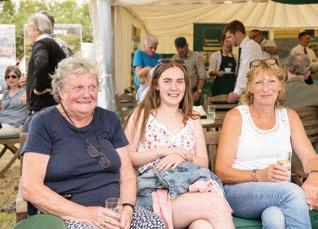
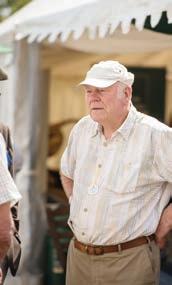






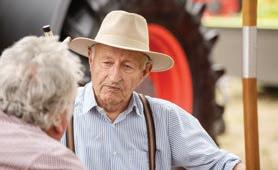













































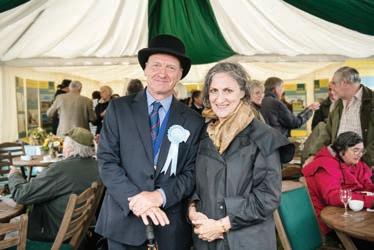



















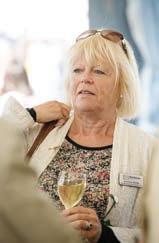







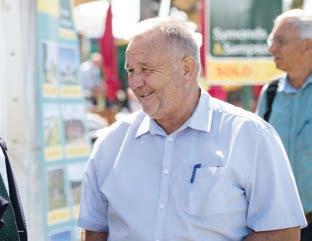


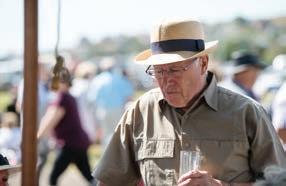



















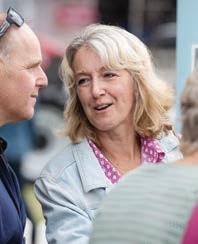

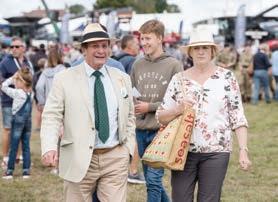








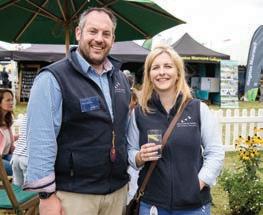

















Who would win the accolade? We meet Will Hyde, Secretary of the Dorset County Show, and James Cox, Secretary of the Gillingham & Shaftesbury Show as they prepare for their 2020 events
Dorset County Show is very different from other shows. In 2006 we took on the mantle of being ‘The County Show’ and we’ve risen to the challenge. Our two-day show delivers 60,000 visitors and significantly higher entries across all sections.
Will Hyde took on the role of Show Secretary in 2017. What experience do you have?
My background is farm management and agricultural consultancy – but I have no event management credentials whatsoever! I stewarded for a number of years at the Royal Bath & West Show and from there started commentating in livestock sections across the South West.

I would be farming sheep. My family helped to develop the Dorset Down breed eight generations ago and we have farmed them ever since on the same site in Wool. We have the oldest and largest flock of Dorset Downs and I have a strong desire to continue that family tradition.
Managing people and their expectations. Almost everything that happens is reliant on someone or something else. I have to maintain the lines of communication to make sure no one’s time is wasted and that everyone’s efforts are recognised and appreciated.
Interacting with different groups, businesses and individuals. Some of the discussion is highly technical and specialised, particularly when it comes to logistics, infrastructure and regulation.
two-day show delivers 60,000 visitors
And I also discuss how to improve visitor satisfaction which is normally creative, contemporary and dynamic.
I want to increase our presence in the rural community and facilitate more industry-based events throughout the year.
I also want to change our education fund so that it is more proactive in providing resources for schools.
In the livestock and equine areas, I want to have more national qualifying classes and industry-based competitions such as national breed shows, and classes that showcase youth initiatives.
In the trade area, I want us to be more selective over the quality of trade stand we attract, creating a better display.
In your opinion what are the wider benefits of agricultural shows to the local community and the economy?
The most important role we provide is an opportunity for the agricultural community to interact and socialise. In the modern day this is increasingly important for rural mental health and to combat insular behaviour. The show is timed perfectly for farmers to come together and, hopefully, celebrate a prosperous year. In hard times it provides a safe forum for farmers to meet and recognise that we are all in this together.
My first experience of agricultural shows was losing against my friend Lucy in the decorated wellie competition at the Dorchester Show! As competing was not my strong point, I took up a stewarding role at the County Show, which later led to an office job. I progressed to the Royal Bath & West of England Society, working on Grassland UK, The Dairy Show and The Royal Bath & West Show.
What has been your biggest challenge for the Gillingham & Shaftesbury Show?



Learning the names of more than 200 invaluable show stewards.
I would like to see more family entertainment while continuing to expand our existing brilliant offering to the agricultural visitors. We are eager to introduce an educational branch as we feel now more than ever that agricultural societies’ core aims should be supporting the future of our outstanding industry.
The vision is to be Dorset, Somerset and Wiltshire’s most loved and true agricultural and countryside show, with greater emphasis on teaching people in our region about where their food comes from.
Because it is a ‘proper’ agricultural show where business gets done! The show welcomes around 100 agricultural stands and is a networking opportunity for farmers and farm managers to meet with buyers, suppliers and dealers, while trade stands and sponsors get to catch up with existing customers and meet potential new ones.
Being located in North Dorset allows us to celebrate everything great about the Great British countryside with visitors from across Dorset, Wiltshire and Somerset joining us for a rural day out for all the family.
Working with our passionate committee members and stewards – the ideas and comradery is like nowhere else. I also love joining the dedicated showground team for coffee and cake in the barn. They work hard throughout the year to make the showground look pristine for the busy summer season of events, including caravan rallies and the show itself.

The shows are built on the generosity of volunteers. The local community becomes a ‘show family’ for a few weeks and gathers together year after year.
These events are a showcase of rural life, of agriculture, and the countryside, and everything great within it.
Gillingham & Shaftesbury Show puts the consumer in contact with the producer – the food halls are filled with delicious food produced within the region, and in the craft marquees you’ll find everyone from local stick-makers to artisan craft producers.
Gillingham & Shaftesbury is a ‘proper’ agricultural show where business gets done


The best French cuisine this side of the Channel with a wine list to rival the best of the best. A-J Monro, Partner
Fantastic food, superb service in a relaxed atmosphere –what more could you want?
Emma Hawker, PR & Marketing Consultant
Beckford Arms, Fonthill Gifford Beautiful location, exceptional food and service, and delicious wines.
Chloe Hooper, Sturminster Newton residential
You can’t beat a personal recommendation so we asked the S&S team to share their go-to eateries and bars at home and further afield
The owner was a chef on the QE2 and specialises in seafood dishes. Brilliant.
David West, Poundbury residential

If you’re ever in Kenya’s oldest city, don’t miss this jawdropping place.
Jeremy Smith, Yeovil residential
The Acorn Inn, Evershot Worthy winner of Best Pub and Chef of the Year at the Dorset Food, Drink & Farming Awards.
Adam Taylor, Dorchester residential

The Pilot Boat, Lyme Regis
Lovely sun-trap terrace and a fantastic bar to enjoy cocktails and live music.
Naomi Garner, Dorchester residential Harbour Inn, Lyme Regis
From New Year’s Eve to a hot summer’s day, the best memories have been made here.
Tim Bennett, Ilminster residential
Vinny at Six, Dorchester
Stylish lounge bar and restaurant with a very friendly atmosphere.
Peter Grout-Smith, Poundbury residential
Lovely atmosphere, great food and always a warm welcome.
Lucy Carnell, Yeovil rural


The impeccable service and varied menu bring us back time and time again.
Jon Summers, Partner, Head of Residential
Dog-friendly pub in the Scottish Highlands with amazing sea views and the freshest seafood.

Lucy Nolan, Dorchester lettings
Home-cooked grub and the most impressive array of ancient ironmongery on every wall!
Nick Rymer, Wimborne rural
The best Indian restaurant! Fantastic menu, lovely welcome, and always full of our friends.
Jan Merriott, Dorchester commercial
Plumber Manor, Sturminster Newton
Entertaining owners and staff, wonderful food and great atmosphere.
Clare Burt, Poundbury lettings
Tytherleigh Arms, between Chard and Axminster
Seriously, the food is the best out there!
Charlie Snow, Yeovil rural
Seaside Boarding House, Burton Bradstock
A great clifftop terrace and bar for a sundowner; now with Taste of the West gold.
Andrew Carless, Partner
The Idle Rocks, St Mawes
Right on the estuary with magnificent views and the sound of the sea. Perfect.
Stuart Philipps, Dorchester residential
Guildhall Tavern, Poole
French restaurant with superb service in delightful surroundings. Try the seafood dishes.

Jane Moir, Wimborne residential
Stunning setting and exquisite food to match; must be experienced.
Neal Wilson, Wimborne residential
A lovely local pub. Go there for the super buzz and excellent food.
Marlise Jolliffe, Sturminster Newton auctions
Dorset Burger Company, Weymouth
What’s not to like? The staff are the friendliest people you could hope for!
Daniel Magee, Bridport residential
Les Belles Perdix de Troplong-Mondot, St Emilion,
Sublime! Lunch on the terrace overlooking the vineyard and lavender beds. Superlative fare and wine.
Richard Taylor, Partner
A proper pub with no pretentions. Local Branscombe beers, good pub grub and colourful locals!
Ross Willmington, Partner
Rick Stein’s Seafood Restaurant, Padstow
It’s been a fixture since 1975 and reminds me of great times on holiday.
Michelle Powell, Dorchester residential
The perfect place for our Thursday ‘date night’ and start to an early weekend!
Hilary Stockley, Poundbury residential
One of the best views in England from the restaurant. After dark, a visit to the absurdly wild and wacky Rum Bar is a must.
Mark Lewis, Partner, Head of Agency
With flagstone floors and open fireplaces, this country pub has fabulous food.

Jessica Weymouth, PR & Marketing
For good walks, good beer and good food –if you remember to book a table!
Robyn Harper, Sturminster Newton rural

A survey of the S&S team reveals our varied tastes in art – from Botticelli to Banksy

One of my go-to paintings in the National Gallery and my screen saver.


Mark Lewis, Partner
Almost life-size and almost alive.
Robyn Harper, Sturminster rural

Reminds me of one of my old schools in Yorkshire as it hung in their corridor.
Michelle Powell, Dorchester residential

Our vicar gave me a copy to mark my confirmation. It sits on my desk at home and is very special to me.
Ross Willmington, Partner

British modern art. Visually stunning and polarises opinions. Love it.
Emma Hawker, PR & Marketing Consultant
Simply spellbinding. Richard Taylor, Partner
Tim Bennett, Ilminster residential


My wife organised it for a major birthday.
A favourite fishing haunt – she had to pray that I didn’t bunk off work for a few hours while he was there!
I love the way Afremov finds colour in darkness. He paints exclusively night-time scenes and makes them come alive.

Richard Miller, Partner
Girl with a Pearl Earring, Johannes Vermeer

Her stare and smile shine as light from the darkness –the most beautiful portrait ever painted.


Brigit Lyons-Davis, Axminster residential

Wonderful energy and movement, and well before the cruise ships!
Chris Dacombe, Wimborne rural


A beautiful portrayal of an old dog’s final journey, aided by the young replacement in a dramatic setting.

Iturned 50 at the start of 2019, and my treat to myself was a ‘Learn to Row’ course at Bridport Gig Rowing Club in West Bay. My daughter had started rowing the previous summer, and was keen to secure her place in the junior squad competing in the Jurassic League, a summer series of regattas hosted and contested by gig clubs in Langstone, Poole, Swanage, Weymouth, Portland, Bridport, Lyme Regis, Sidmouth and Exmouth.
“Why don’t you join the ladies’ squad?” they said. That is how my mid-life crisis began.
Joining the squad mid-season, so not being affiliated to a particular crew, I was fortunate enough to fill in with four ladies’ crews, competing in 11 races, and winning 6.
The races are usually around 2 to 3 kilometres, and a lung-busting burst from start to finish. Getting a good start is key, hopefully giving you clear water and advantage at the first buoy turn.
The races can be pretty hairy; nobody wants to give an inch, so clashing oars or even collisions are fairly common. But the buzz is incredible, and somehow you manage to find energy that you thought you’d left in your teenage years!
The club is a wonderful community, held together by the many coxes and volunteers who do all the hard work so that people like me can pitch up, jump in a boat and row.
We had a very successful season with Bridport being crowned Jurassic League champions for a third successive year. Other clubs are closing in on us though, so it’ll be hours on the rowing machine over the winter to give us a head start for 2020.
The highs include my first win (in a crew with my sister Rachel at the Swanage Regatta in June), and the delight when a dolphin swam alongside our boat for an hour off West Bay in September.
The lows? Blisters (lots of them), and ‘gigger’s arse’ – that rubbed-raw patch on your ‘tailbone’. Enough said; I should buy shares in the makers of hydrocolloid dressings!

The origins of Cornish Pilot Gig Rowing, to give the sport its full title, came from ship pilots racing to incoming vessels to guide them into the harbour. The first pilot on-board was paid, therefore he sought to retain the best coxswain and crew.
The gigs we race are modelled on those traditional wooden seafaring rowing boats – crewed by six rowers and a coxswain, 32 feet long and built of elm. At Bridport, we have three racing boats, Brydian, Blaez and Dagger and two fibreglass training boats, Bathsheba and Bucky Doo.
The racing season starts with the world championships in the Scilly Isles in May.

Bridport Ladies A crew’s gruelling winter training was rewarded with a brilliant 16th place in 2019 – the best ever result for a Dorset crew.
The summer sees local leagues through Cornwall, Devon and Dorset, with junior, ladies’ and mens’ squads racing in a range of categories. It’s enormous fun and I highly recommend it.
 Sally Reid Marketing Manager Poundbury sreid@symondsandsampson.co.uk
Sally Reid Marketing Manager Poundbury sreid@symondsandsampson.co.uk
The buzz is incredible, and somehow you manage to find energy you thought you’d left in your teenage years
If you want to gain friends, fitness and a few blisters, give gig rowing a try, says Sally Reid
Adivine mix of movement, meditation and breath work, yoga has rooted its place firmly in my life.
My personal journey started just after I had my second child, almost seven years ago. I’d seen a post on Instagram of a lady bending herself into a pretzelshaped posture, and others of people in perfectly poised handstands and backbends on sunset adorned beaches. I thought, “I want to do that!”
I immediately threw myself into the physical part of yoga –attempting to balance on my head, standing on my hands, and other such contortions. Little did I know at the time that the physical side would eventually become the least important part to me.

As time went on, I started to really understand how yoga feels. Rather than just taking myself through a sequence of exercises, it started to sink in why I was doing what I was doing and how it could really benefit me on the inside.
I was learning new things about myself all the time – my body, my mind, my breath and the world around me. Yoga started to change me as a person and I worked out that it can’t cure problems or remove life’s obstacles, if anything it made me face things head on and challenge myself to a whole new level.
There are many forms of yoga, and each has its own focus.
1 Ashtanga – An energetic style of yoga linking flowing movements with the breath in a set sequence.
2 Bikram – Otherwise known as Hot Yoga where the room is heated to around 35°C.
3 Hatha – A general form of yoga using physical postures and techniques to align the mind, body and spirit.
4 Lyengar – A style of yoga focusing on alignment.
5 Kundalini – Meaning ‘coiled like a snake’, a system to release pent up energy with movement, breathing and meditation.
6 Yin – A slow paced and relaxing form of restorative yoga to release muscle tension.
7 Viniyoga – Adaptable to any person, an in-depth form of yoga therapy.

I began to find similarities between the yoga and meditation I was practicing on the mat to my everyday life off the mat. They overlapped in a surprising way and I discovered a practice to live my life in a way that really meant something to me.
My passion turned into an opportunity to embark on yoga teacher training, which I completed with the British Wheel of Yoga in the summer of 2018. Being able to share my love of yoga with others makes my heart sing.
Yoga can be practiced anywhere, from the comfort of your bedroom to the mountains of Tibet. But wherever you are, I hope it brings as much joy to you as it does to me.
1 Increases flexibility, muscle strength and posture.
2 Ability to breathe better, increase energy and vitality.
3 Reduce stress and release tension.
4 Boosts emotional health and encourages self-care.
5 Improves concentration, focus and balance.

Yoga is a way to unwind, recharge and find a place of peace. Our very own expert, Becky Stimpson, wants to bend your ear – and the rest of your bodyBecky
This year we will be supporting four local Mind organisations, raising awareness and vital funds to tackle mental health problems
For 2020, we are proud to partner with four regional branches of the charity Mind who work tirelessly to provide services and support to anyone suffering from mental health issues in the local community.
Covering Dorset, Devon, Somerset and Wiltshire, these local organisations are not funded by the national Mind charity in the UK, so staff in our offices will be motivated by the fact that our efforts will support our local communities.

Every year, one in four of us will experience a mental health problem. These local Mind organisations are a vital part of the journey to good mental health. We hope we can count on your support for these very important local charities.
Dorset Mind 01202 315329
Devon Mind 01752 512280
Somerset Mind 01935 474875 Wiltshire Mind 01225 706532
Mental health is the biggest hidden problem facing farmers today. We can provide practical help with many of the stress factors and signpost to the support available
Britain’s farmers have a proud reputation for the attention they give to their livestock, crops and machinery, but when it comes to taking care of themselves and their own mental wellbeing they can fall short.
Farmers are unique in that they live and work in the same place. They work long hours, often in isolation, with very little time to switch off. Looking out of the windows of the farmhouse usually results in peering into the cubicle shed, across a field of sheep, or seeing that broken machine outside the workshop. These constant reminders mean there is no easy way to get away from the workload.
Combine that with the other mental health risks associated with agriculture, such as financial pressures, the vagaries of the weather, ever-changing bureaucracy and the unknown being thrown in for good measure, and it’s no surprise that individuals can reach breaking point.
We all have a responsibility to look after our family, friends and colleagues, but more often than not speaking to someone who is not directly involved can make a huge difference. Within our on-site sales department at Symonds & Sampson we have a very professional and practical team who understand the difficulties and problems faced by farmers. Many of us come from agricultural backgrounds and have hands-on experience.
We have dealt with nearly every situation before – family debt, death, divorce and dispute, often referred to as the ‘four Ds’. And we can also help with the fifth D – depression. We can direct you to organisations or charities that may be of help, and we deal with support groups such as the Farming Community Network, the Royal Agricultural Benevolent Institution, and the Addington Fund.
Farmers don’t need to struggle with mental health issues alone. Please take that first step. Pick up the phone and ring us on 01935 382909. We’re on your side.
